#machu picchu cliff hotel
Text
Jaya Machu Picchu Boutique Hotel: Unveiling Luxury Amidst Ancient Wonders
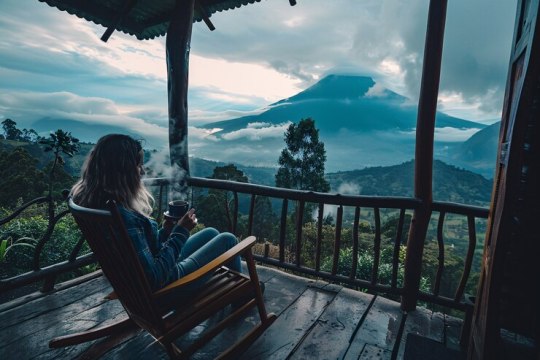
Nestled in the heart of the Sacred Valley, Jaya Machu Picchu Boutique Hotel invites you to experience unparalleled luxury at the doorstep of one of the world's most awe-inspiring destinations. As a luxury hotel in Machu Picchu, we offer an unforgettable escape, blending modern elegance with the rich cultural heritage of the Inca Empire.
Beyond Breathtaking Views: A Sanctuary of Luxury
Jaya Machu Picchu Boutique Hotel goes beyond simply offering stunning views of the ancient citadel. Here's what awaits you within our luxurious haven:
Intimate Tranquility: Unlike larger hotels, Jaya Machu Picchu provides an intimate atmosphere, ensuring personalized attention and a peaceful retreat. Immerse yourself in the tranquility of the Sacred Valley, a world away from the hustle and bustle.
Exquisite Design: Our guest rooms are havens of comfort and style, featuring plush furnishings, handcrafted décor inspired by Inca traditions, and private balconies overlooking the breathtaking landscape. Unwind in luxurious bathtrooms with spa-quality amenities.
Culinary Delights: Embark on a culinary journey at our gourmet restaurant, Killa Raymi. Savor innovative dishes prepared with fresh, locally-sourced ingredients, showcasing the rich flavors of Peru. Pair your meal with exquisite wines from our extensive cellar.
Impeccable Service: Our dedicated staff is committed to exceeding your expectations. From personalized assistance with planning your Machu Picchu visit to arranging rejuvenating spa treatments, we ensure every detail is flawlessly catered to.
Unforgettable Experiences Await
Jaya Machu Picchu Boutique Hotel offers more than just a luxurious stay. We provide unique experiences to enrich your journey:
Guided Tours: Explore the mysteries of Machu Picchu with our knowledgeable guides, unlocking the secrets of this ancient city. Immerse yourself in the rich history and culture of the Inca Empire.
Cultural Immersions: Delve deeper into the traditions of the Sacred Valley with personalized cultural experiences. Learn about local crafts, participate in cooking classes, or attend traditional ceremonies.
Rejuvenating Spa Rituals: Unwind after your Machu Picchu adventure at our tranquil spa. Indulge in traditional Inca massage therapies or rejuvenating treatments inspired by the natural wonders of the region.
Jaya Machu Picchu Boutique Hotel: Your Gateway to Luxury in Machu Picchu
Whether you're seeking a romantic escape, an adventure-filled getaway, or a cultural immersion, Jaya Machu Picchu Boutique Hotel is your perfect sanctuary. We offer an unparalleled level of luxury and personalized service, ensuring your stay in Machu Picchu is truly unforgettable.
Book your stay today and experience the magic of the Sacred Valley at Jaya Machu Picchu Boutique Hotel, your luxury hotel in Machu Picchu.
#JayaMachuPicchu #LuxuryHotelMachuPicchu #SacredValley #Peru #UnforgettableExperiences #LuxuryTravel
#machu picchu hotels#machu picchu hotel#jaya suite machupicchu#hotel machu picchu#best hotel in machu picchu#machu picchu luxury hotel#hotel in machu picchu#hotels near machu picchu#best hotels near machu picchu#best hotel machu picchu#machu picchu hotels luxury#peru hotels near machu picchu#hotels in machu picchu town#luxury hotel in machu picchu#best hotels in machu picchu#Jaya Machu Picchu#machu picchu cliff hotel#best hotel machu picchu peru#The best hotels in Machupicchu#Luxury hotels in Machupicchu
0 notes
Text
Day 20 - Machu Picchu & Huayna Picchu
The alarm goes off, we snap into action - shower and get ready. The hotel breakfast starts at 4:30am - they know their customers well haha.
We grab some eggs on toast and coffee to keep us going for a few hours of hiking. Our hotel store our bags after we check out. Today we climb Huayna Picchu. It’s not particularly long hike but it’s a huge elevation gain over a short distance. I’m a little worried about the climb as I’m scared of heights but we’ll see how it goes.
We take the bus up to the site and as I had feared it’s quite misty this early in the morning. However it’s kinda nice and mysterious with the clouds.
Firstly we are on Circuit 4 today so we can enter the Inka House that we looked down on yesterday.

Then we meander our way towards the Sacred Rock which is the start of the trek up Huayna Picchu. We are allowed to start a little earlier than our scheduled 7:00am start time so after signing in we begin the climb. It’s almost immediately lots of stairs but nothing too crazy. The first 3/4 of the hike we are surrounded by bush and enjoying the flowers. At some steep staircases they have metal chains to help you get up.
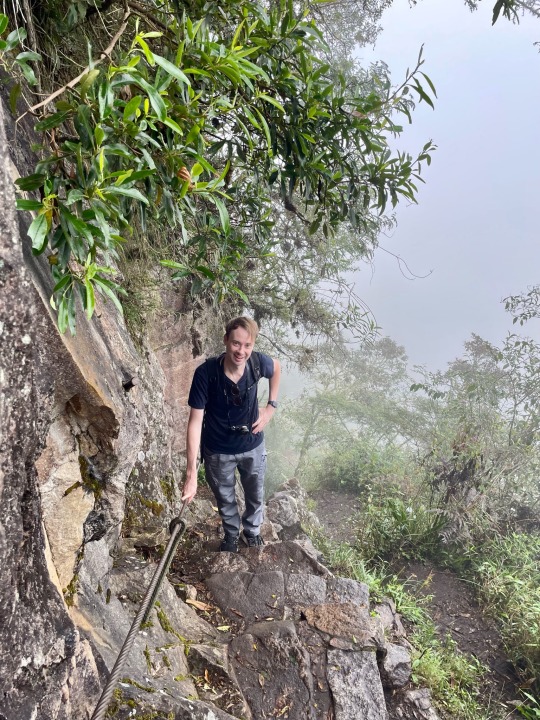
After this we get to the terraces where it’s cleared and you are able to better see how high up you are. Quickly followed by the “Stairs of Death”. We did need to climb up on our hands and knees but I think they are a little overhyped. Once we get up the stairs we get amazing views down into the valley so we stop for some photos.

It’s still cloudy so we stop to once side for half an hour and eat some snacks. My only struggle is when Jack stands really close to a sheer cliff edge whilst taking photos and it makes me feel a bit queezy!

After this, the clouds start to clear and we head up a short staircase to another terrace where there is spectacular views down over Machu Picchu. We stop again for a while to enjoy.
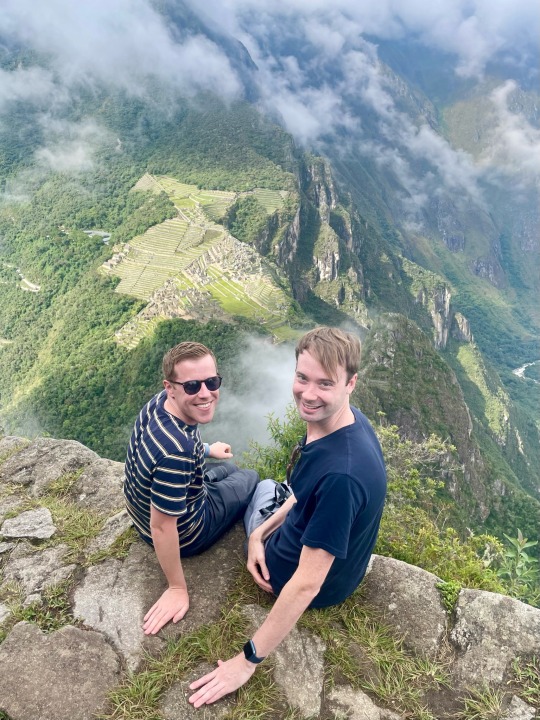
It’s the last little climb to the very summit, the space at the top is very limited so we don’t stay too long - just enough to snap some photos.
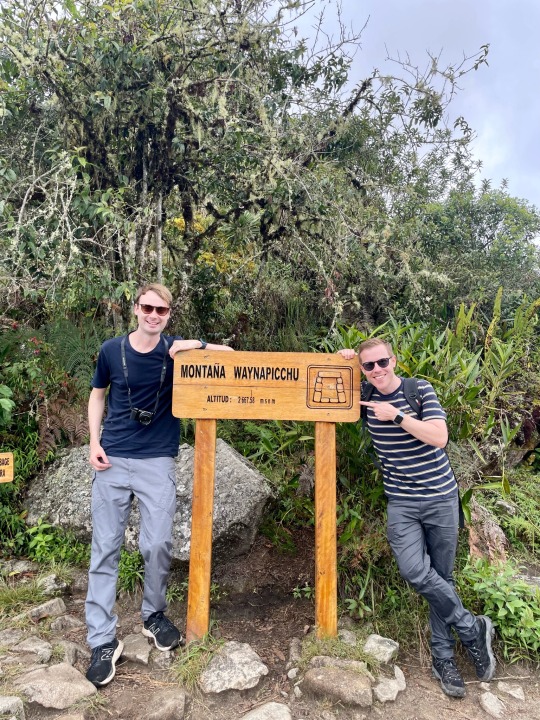
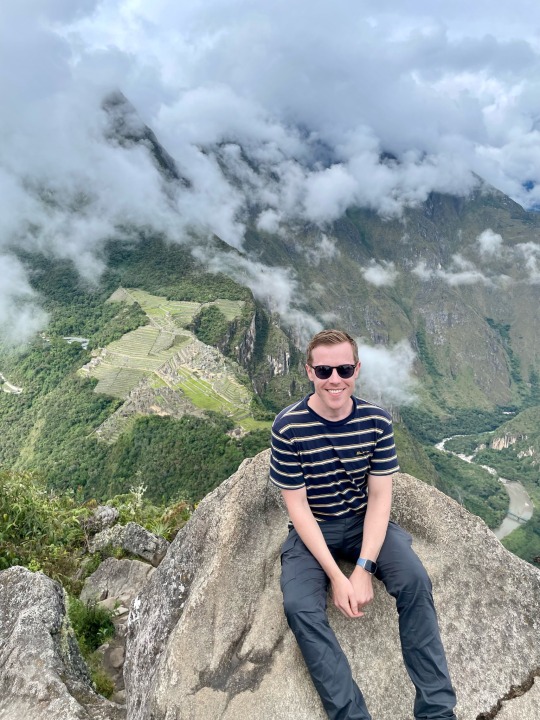
It’s all downhill from here!! The downhill is a little harder as my knee is playing up, but we take it slow. There are so many people climbing by this point (10am) and we keep needing to stop to let them last. Also they are all struggling in the heat so I’m super happy we chose the early slot.
WE MADE IT - I’m so proud of myself. The heights were barely a problem for me at all.
We make our way towards the exit and we stop off at the Temple of the Condor. The Condor (part of three of the Trilogy of the Andes world). The rock has been carved into the shape of a condor.
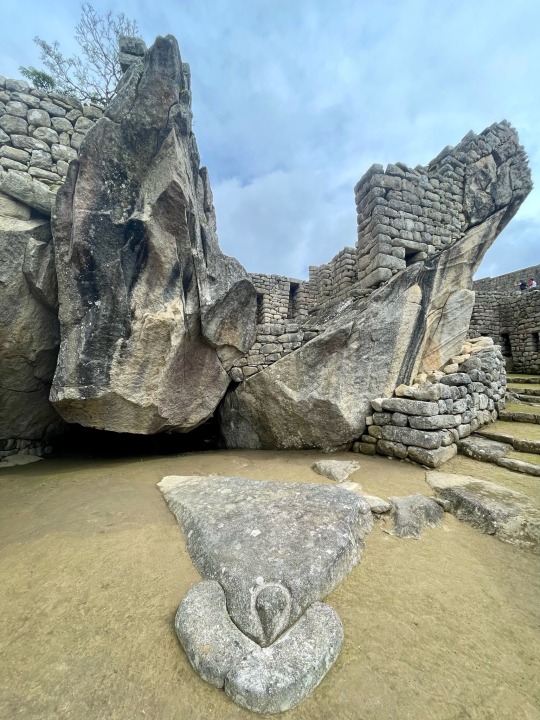
Ok it’s time to head back down to Aguas Calientes. I’ve been geeking out on Incan stuff for days now so it’s time for Jack to get to do something fun. We head straight for a message next to our hotel. We opt for the Incan massage with hot stones. It’s an hour of pure bliss - one of the best massages we’ve both had. Next we grab some lunch at a nearby restaurant. We both order the beef burritos (plus a pisco sour to celebrate) which look very much like tacos but they do the job.

By the time we pick up our bags it’s time to walk to the train station. This time it’s even more chaotic than yesterday, after a while with utter confusion we realise that the previous train is late to depart so the small station is packed with two trains worth of people. The staff don’t seem to know what is going on and keep telling us different things - the usual South American stuff.
We end up leaving about 40mins late which isn’t too bad but the train goes really slowly the whole way back to Ollantaytambo. We have a taxi prearranged to take us back to Cusco which then gets stuck in heaps of traffic so it’s quite late by the time we get in. Not ideal after our 4am wake up. We head straight out to grab some hot chips for dinner and some more water. The new hostel is pretty bad - black mould everywhere, it smells badly of drains, the walls are paper thin and a dog is barking all night!
One final thought before I sign off - I’ve realised upon returning to Cusco is that the altitude really messes with everything - for example Jack’s moisturiser exploded on him and it reminded me that the same thing happened to me with sunscreen when we first arrived here. The altitude pushed all of his snot out as soon as we arrived back (sorry TMI). Also we’ve noticed that the beer has way too much head and is a bit flat tasting. When the car was stuck in traffic earlier I started feeling sick - it’s difficult to differentiate between side effects from the tablets and actual altitude sickness but I think the summary is that my body just feels a bit fragile at 3400m but glad we took the tablets because everything we’ve experienced has been very very mild.
2 notes
·
View notes
Text
What has Lima got to offer?
Although we were both knackered our body clocks were still on UK time so we were up, showered and dressed by 7.00am local time (midday UK time). I had a good breakfast while MM had 4 cups of coffee, then booked a walking tour of Lima for tomorrow (Friday) and sent a complaint to Booking.com about last night's fiasco requesting compensation.
Tasks completed we decided to walk from the hotel into the centre of the city. Lima is situated on the cliffs overlooking the Pacific ocean so we headed to the cliff tops from the hotel to find ourselves in the Chinese garden. We continued along the cliff tops, through the Garden of Love until we reached the shopping mall. MM decided to buy a disposable vape here. Strawberry flavoured and, it turns out, one favoured by white van man. Every time she takes a puff she emits a cloud of vapour that can be seen from space - she can't hide from me now! However, we are now being followed by the Lima fire brigade.
From here we headed away from the coast and into the city centre. Stopped for lunch at a local restaurant and then went to buy a Peruvian sim card. The very helpful lady was very sorry when she had to report that she couldn't activate the card as "the office people have gone to lunch". Eventually it got resolved and we walked to Huaca Pucllana, a site that predates the Inca's and Machu Picchu by 1,000 years and took 300 years to build - fascinating.
I have to say that the locals that we've met so far are so friendly and helpful. Although English isn't as widely spoken as it is in many parts of the world we are managing to communicate and people want to help.
MM tells me that she has done 23,690 steps today which equates to 9.35 miles. However, her legs are so short that it's probably only 5 miles for a "normal" person!
Walking trip tomorrow then fly to Cuzco on Saturday.
2 notes
·
View notes
Text
30 Destinations to Tick Off Your Bucket List
1. Kyoto, Japan:
Why: A blend of ancient traditions and modern amenities, Kyoto offers stunning temples, serene gardens, and delicious cuisine.
Must-see: Arashiyama Bamboo Forest, Kiyomizu-dera Temple, Gion district.
2. Santorini, Greece:
Why: With its iconic white-washed buildings, blue-domed churches, and breathtaking sunsets, Santorini is a dream destination.
Must-see: Oia village, Akrotiri archaeological site, Santorini Wine Museum.
3. Iceland:

Why: From glaciers and geysers to the Northern Lights, Iceland offers a unique and unforgettable experience.
Must-see: Blue Lagoon, Golden Circle, Vatnajökull National Park.
4. Machu Picchu, Peru:
Why: A UNESCO World Heritage site and one of the Seven Wonders of the World, Machu Picchu is a marvel of ancient Inca engineering.
Must-see: Inca Trail, Huayna Picchu, Sun Gate.
5. Galapagos Islands, Ecuador:
Why: Home to a unique ecosystem of endemic species, the Galapagos Islands offer unparalleled wildlife encounters.
Must-see: Isabela Island, Santa Cruz Island, Charles Darwin Research Station.
6. Taj Mahal, India:
Why: A symbol of love and loss, the Taj Mahal is a breathtaking mausoleum and UNESCO World Heritage site.
Must-see: Agra Fort, Fatehpur Sikri.
7. Great Barrier Reef, Australia:
Why: The world's largest coral reef system, the Great Barrier Reef offers incredible snorkeling and diving opportunities.
Must-see: Whitsunday Islands, Cairns, Great Barrier Reef Marine Park.
8. Paris, France:
Why: A city of romance, art, and culture, Paris is a must-visit destination.
Must-see: Eiffel Tower, Louvre Museum, Notre-Dame Cathedral.
9. Venice, Italy:

Why: With its canals, gondolas, and stunning architecture, Venice is a magical city.
Must-see: St. Mark's Square, Rialto Bridge, Doge's Palace.
10. New York City, USA:
Why: A bustling metropolis with endless things to see and do, New York City is a must-visit for any traveler.
Must-see: Times Square, Central Park, Statue of Liberty.
11. Angkor Wat, Cambodia:
Why: A stunning temple complex and UNESCO World Heritage site, Angkor Wat is a must-see for history buffs and culture enthusiasts.
Must-see: Bayon Temple, Ta Prohm, Preah Khan.
12. Petra, Jordan:
Why: A hidden city carved into the sandstone cliffs, Petra is a marvel of ancient architecture.
Must-see: Treasury, Monastery, Siq.
13. Great Wall of China:
Why: One of the Seven Wonders of the World, the Great Wall of China is a symbol of Chinese history and culture.
Must-see: Mutianyu section, Badaling section, Simatai section.
14. Cape Town, South Africa:
Why: With its stunning natural beauty, vibrant culture, and delicious food, Cape Town is a must-visit destination.
Must-see: Table Mountain, Cape of Good Hope, Robben Island.
15. Reykjavik, Iceland:
Why: The capital of Iceland offers a unique blend of Scandinavian charm and Icelandic culture.
Must-see: Hallgrímskirkja church, Harpa concert hall, Perlan.
16. Rio de Janeiro, Brazil:
Why: Known for its beautiful beaches, vibrant nightlife, and iconic landmarks, Rio de Janeiro is a must-visit destination.
Must-see: Copacabana Beach, Ipanema Beach, Christ the Redeemer statue.
17. Amsterdam, Netherlands:
Why: A charming city with canals, bicycles, and a relaxed atmosphere, Amsterdam is a popular tourist destination.
Must-see: Anne Frank House, Rijksmuseum, Van Gogh Museum.
18. Barcelona, Spain:
Why: A vibrant city with stunning architecture, delicious food, and a lively atmosphere, Barcelona is a must-visit destination.
Must-see: Sagrada Família, Park Güell, La Rambla.
19. Sydney, Australia:
Why: A beautiful city with iconic landmarks, stunning beaches, and a vibrant culture, Sydney is a must-visit destination.
Must-see: Sydney Opera House, Bondi Beach, Harbour Bridge.
20. Dubai, United Arab Emirates:

Why: A futuristic city with towering skyscrapers, luxurious hotels, and a vibrant nightlife, Dubai is a must-visit destination.
Must-see: Burj Khalifa, Palm Jumeirah, Dubai Mall.
21. Buenos Aires, Argentina:

Why: A vibrant city with a European flair, Buenos Aires is known for its tango, delicious food, and friendly people.
Must-see: Recoleta Cemetery, Caminito, La Boca neighborhood.
22. Prague, Czech Republic:
Why: A stunning city with beautiful architecture, cobblestone streets, and a rich history, Prague is a must-visit destination.
Must-see: Charles Bridge, Prague Castle, Old Town Square.
23. Kyoto, Japan:
Why: A blend of ancient traditions and modern amenities, Kyoto offers stunning temples, serene gardens, and delicious cuisine.
Must-see: Arashiyama Bamboo Forest, Kiyomizu-dera Temple, Gion district.
24. Santorini, Greece:
Why: With its iconic white-washed buildings, blue-domed churches, and breathtaking sunsets, Santorini is a dream destination.
Must-see: Oia village, Akrotiri archaeological site, Santorini Wine Museum.
25. Iceland:
Why: From glaciers and geysers to the Northern Lights, Iceland offers a unique and unforgettable experience.
Must-see: Blue Lagoon, Golden Circle, Vatnajökull National Park.
26. Machu Picchu, Peru:
Why: A UNESCO World Heritage site and one of the Seven Wonders of the World, Machu Picchu is a marvel of ancient Inca engineering.
Must-see: Inca Trail, Huayna Picchu, Sun Gate.
27. Galapagos Islands, Ecuador:
Why: Home to a unique ecosystem of endemic species, the Galapagos Islands offer unparalleled wildlife encounters.
Must-see: Isabela Island, Santa Cruz Island, Charles Darwin Research Station.
28. Taj Mahal, India:

Why: A symbol of love and loss, the Taj Mahal is a breathtaking mausoleum and UNESCO World Heritage site.
Must-see: Agra Fort, Fatehpur Sikri.
29. Great Barrier Reef, Australia:
Why: The world's largest coral reef system, the Great Barrier Reef offers incredible snorkeling and diving opportunities.
Must-see: Whitsunday Islands, Cairns, Great Barrier Reef Marine Park.
30. Paris, France:
Why: A city of romance, art, and culture, Paris is a must-visit destination.
Must-see: Eiffel Tower, Louvre Museum, Notre-Dame Cathedral.
#travel#travel destinations#bucket list#tourism#adventure#exploration#iceland#machupicchu#taj mahal#great barrier reef#Paris#venice#new york#Petra#great wall of china#Dubai#prague#travel the world#must see places
0 notes
Text
Affordable Warm Winter Vacations Destinations
Affordable Warm Winter Vacations Destinations
Affordable Warm Winter Vacations. Knowing when to travel can help you save money, even for locations that aren't particularly cold this time of year. Winter can often mean great savings. We compiled a list of warm and reasonably priced domestic and international destinations using data from Google Flights and Google Hotels.
These estimates are for flights to and from New York City airports, so the cost may differ from other locations. Nevertheless, it should be noted that these estimates are for flights to and from New York City airports, so the price may vary from other locations. We set the bar at less than $130 per night for hotels within the United States and less than $200 per night for hotels abroad.
Enjoy some sun while saving money
It's important to do your research and avoid making common booking errors that could cost you money, such as booking at the wrong time of day or on a day that's not ideal for holiday travel, because flight and hotel rates can easily change due to a variety of factors. Choose one of these locations, take advantage of flight and hotel specials, and you'll enjoy your winter vacation as well as your wallet.
image of Affordable Warm Winter Vacations
Barbuda and Antigua
Antigua and Barbuda are significantly less expensive than most other European-influenced Caribbean islands, have 365 beaches (one for every day of the year), and enjoy excellent weather all year round, allowing visitors to explore the ruins of British forts and other stunning architecture.
Flights can be purchased for as little as $300 roundtrip, and two- and three-star hotels cost between $60 and $150 per night.
Texas's Dallas
Even though everything is bigger in Texas, travel there need not be expensive. Flights to Dallas can cost between $130 and $300, and hotel rates can be as low as $70 per night during the winter.
In addition to numerous art and science museums, two sizable aquariums, a zoo, and the Dallas Arboretum and Botanical Gardens, tourists can take advantage of the pleasant winter weather in Dallas.
Visit Six Flags Over Texas, the first Six Flags park, or travel to Zero Gravity Thrill Rides Amusement Park, the only amusement park in the country solely devoted to thrill rides, if you're looking for a little more excitement.
Mexico's Cancun
Cancun is well-known for its beaches and nightlife, but there are also many undiscovered attractions there, such as serene cenotes, historic Mayan ruins, and natural parks.
Cancun is best enjoyed outside of spring break, when round-trip airfare can be as low as $250 and hotel rates can be as low as $40 per night.
Jamaica
Enjoy the laid-back Caribbean vibe of Jamaica, where round-trip flights to Montego Bay and Kingston cost between $350 and $400.
Spend as little as $65 per night in a hotel and experience some adventure with activities like kiteboarding, whitewater rafting, cliff jumping, and rainforest hiking.
Peru
Peru's summer season, which coincides with the northern hemisphere's winter months, is also the country's rainiest time of year, making it simple to find great deals. If you don't mind taking showers, you can travel to Lima for as little as $320 roundtrip and stay in a hotel for as little as $30 per night.
Photographic locales include the Sacred Valley, which is the location of Machu Picchu, and Vinicunca, the breathtakingly colorful "Rainbow Mountain" in the Andes.
Florida's Key West
The island city of Key West has never even experienced a frost because the temperature here never drops below freezing, so you can expect warmer weather there.
Although Key West also has fantastic seafood and a vibrant nightlife, you must visit at least once in your lifetime to experience the beauty of its beaches and sunsets. Winter is the best time to travel because round-trip flights can be found for as little as $240, and early December hotel specials can be found for less than $130 per night.
Spain's Seville
One of the things every American traveler should do is learn and enjoy flamenco in Andalusia, and Seville, the region's capital, is the ideal location to experience southern Spanish culture.
The city's architecture, which is a fusion of Moorish and European styles, is characterized by its abundance of tapas bars, beautiful parks, and museums. While January can be a good time to save money, February is the best month to travel because flights are about $450 roundtrip and hotels can be as low as $50 per night.
Islands of Cayman
Some of the best beaches in the world can be found in the Cayman Islands, and Grand Cayman in particular is a well-liked stop for cruise ships.
You'll have plenty of opportunities to go diving, parasailing, kayaking, snorkeling, or exploring the islands on a hike when you're not lazing in the sun. In January and February, you can find hotels for as little as $135 per night and flights for about $300.
Arizona
Arizona has much more to offer than just the Grand Canyon, one of America's greatest natural wonders. Along with Lake Powell and Horseshoe Bend in the Glen Canyon National Recreation Area, other noteworthy natural areas include Tucson's Sabino Canyon and Saguaro National Park.
Consider visiting culturally vibrant cities like Sedona, which is home to numerous art galleries and events, as well as Phoenix, the state capital, where roundtrip airfare can range from $100 to $300 and hotel rooms can be found for as little as $60 per night.
Bahamas
This season, flights to Nassau cost on average about $330, while hotel rooms range from $120 to $180 per night. Since the Bahamas aren't a popular summer destination, winter is a great time to visit the crystal-clear waters at white-sand beaches, take in gorgeous sunsets, and tour a rum distillery.
Texas's Galveston Island
Galveston Island is a well-liked cruise port of call as well as a beach destination and is situated off the Texas Gulf Coast about 50 miles southeast of Houston. The majority of winter flights cost between $120 and $280 roundtrip, and hotel rates begin at $70 per night.
The barrier island, which is only 3 miles wide and less than 30 miles long, is less expensive in the winter and the beach is also much less crowded.
Mexico's Cabo San Lucas
With celebrities like George Clooney, Jennifer Aniston, and Justin Timberlake vacationing there, Cabo San Lucas may seem like a posh location, but if you book a flight in late January or early February, you can get round-trip tickets for as little as $330 and a hotel room for between $50 and $90.
The resort city, which is a steal at these prices and is situated at the southern tip of the Baja California Peninsula, is renowned for its impressive resorts, romantic atmosphere, and stunning beaches with excellent scuba diving.
Los Angeles, California
Even around Mardi Gras in late February, winter flights to New Orleans cost between a little over $100 and a little under $300, making it the ideal time to experience this Southern city at its finest. A hotel room can be had for as little as $60 per night.
New Orleans is a great destination for partygoers, artists, and those interested in history and strange attractions like haunted bike tours and cemetery visits. It is well known for its jazz and blues clubs as well as its Cajun and Creole cuisine.
Cuba
Travel from the United States to Cuba is now subject to more limitations, but it is still permitted for those who fall under the "support for Cuban people" category and visit businesses run by Cubans.
With delicious Cuban cuisine, a vibrant nightlife, opportunities for cave diving, and fascinating tours of cigar factories, this won't be at all difficult or expensive. You'll probably need to book a room at an Airbnb, which can cost as little as $30 to $40 per night, or a "casa particular," a private homestay that typically costs $25 to $45 per night, as many hotels are on the U.S. State Department's restricted list. In January and February, the average cost of a flight to Cuba is about $300.
Nevada's Las Vegas
In January and February, flights to Las Vegas cost between $100 and $200, which leaves plenty of cash available for gambling and nightlife. Hotels start at $50 per night, and the city also offers sightseeing passes with deals on a variety of attractions at a significant discount.
Islands of Turks and Caicos
The largest of the Turks and Caicos Islands, Providenciales, may offer some excellent flight deals in December, but in January and February, average round-trip fares are only $275, and hotel rates are as low as $120 per night.
Turks and Caicos is a developing cruise destination known for its dazzlingly clear beaches and one of the world's longest coral reefs, making it a top choice for snorkelers and scuba divers.
Virgin Islands
You don't even need a passport to enjoy Puerto Rico's beaches, nightlife, and cuisine because it is a U.S. territory.
In the winter, San Juan flights can be found for as little as $120, especially in January, and hotel rates typically range from $85 to $125 per night.
Beautiful beaches and stunning Spanish-inspired architecture can be found all over the island, but San Juan stands out for having a unique cultural landscape where the old and the new coexist in the city's structures, cuisine, and inhabitants.
The U.S. Virgin Islands' St. Thomas
Additionally, you don't need a passport to visit tranquil St. Thomas, where hotels can cost between $130 and $200 per night and round-trip flights can be had for as little as $200 in January and February. Saint Thomas, a popular stop for cruise ships, is home to undeveloped beaches and numerous historic colonial structures.
Colombia's Cartagena
Although Cartagena is a fantastic place to spend the holidays, it can get quite expensive in December. If you travel in January or February, you can get a flight deal for between $260 and $490 roundtrip, and you can even find five-star hotel rooms for between $80 and $190 per night, with three- and four-star hotels being even less expensive.
In addition to being one of the first Spanish colonies in the Americas and one of the first refuges for freed African slaves, Cartagena is a stunning port city on Colombia's northern coast with a rich history and diverse population.
Visit the 500-year-old forts, historic churches, and museums in the old city. Hiking, scuba diving, snorkeling, and other activities are all excellent in the city and the surrounding areas.
Alabama's Gulf Shores
The resort city of Gulf Shores, which is on the Gulf of Mexico and one of America's best coastal destinations, has a subtropical climate ideal for relaxing in the sun or engaging in watersports.
Hotel rooms in Gulf Shores can cost as little as $50 per night, and flights there are approximately $300 roundtrip. Gulf Shores is a great party city with a vibrant nightlife and lots of concerts, as well as plenty of wildlife nature trails, mini-golf, boat rentals, and waterfront restaurants.
The Dominican Republic's Punta Cana
Despite the fact that Punta Cana is renowned for its award-winning resorts, you can book a hotel room for as little as $45 per night. In the winter, when the sun is less intense and the beaches are less crowded, round-trip tickets can be purchased for as little as $280.
California's San Diego
San Diego, which is known for having excellent surf year-round, has fewer visitors in the winter, which means fewer people at its beaches and the San Diego Zoo, one of the world's most joyful places. In January, round-trip airfares to San Diego can fall as low as $140, and in February, they aren't much more expensive, with hotel rates starting at just $80 per night.
Curaçao
Along with Aruba and Bonaire, Curaçao is one of the three islands collectively referred to as the ABC Islands. Located about 40 miles off the coast of Venezuela, Curaçao exhibits a strong Dutch influence in both its local culture and built environment.
Most flights in January and February cost around $330, and hotel rooms range from $75 to $100, with some five-star accommodations costing less than $200 per night. Due to Curaçao's tropical savanna climate, you can find both beaches with tropical fish and desert landscapes with cacti.
Visit its national parks for a hike, or try diving and snorkeling in the crystal-clear waves.
Georgia's Savannah
Savannah, a charming and historic city, is less crowded in the winter but still has wonderful weather. Take pleasure in its lovely antebellum architecture, as well as the many beautiful parks and historic squares.
However, take caution because some claim Savannah is among the most eerie cities in America. One of the most terrifying locations in the world is allegedly Bonaventure Cemetery. Wintertime hotel rates start at $60 per night, while flight costs typically range from $120 to $200.
In Costa Rica
In Costa Rica, a hotel room can be had for as little as $30, and a round-trip flight can be taken for as little as $250. Even better, the dry season in Costa Rica occurs in the winter, allowing you to fully appreciate the incredible diversity of plants and animals that inhabit the island's rainforests.
20% of Costa Rica's land is made up of national parks and other protected areas, which offer a variety of beautiful places to hike, kayak, or even zip line through.
Panama
In Panama, especially in Panama City, it's easy to find significant discounts. There, you can book a hotel room for as little as $45 per night and even a five-star hotel for less than $175.
In the winter, flights to Panama City can cost as little as $270, making the trip well worth it for the city's stunning beaches and surroundings, which are well-liked by hikers and birdwatchers.
While it's a great place to party and eat some delicious Panamanian food, if you're up for something more adventurous, you can also go whitewater rafting, rock climbing, or ziplining.
Florida St. Petersburg
Disney and beaches aren't all that Florida has to offer, though St. Petersburg does have a lot of those. The city is full of art galleries, cafes, and museums, including the Salvador Dali museum, which houses the largest collection of the artist's works outside of Europe. This makes it a more affordable place to vacation than Orlando or Miami.
All through the winter, flights are fairly inexpensive, but in January, you can get a round-trip ticket for as little as $75, and hotel rooms start at the same price per night.
Island Canaries
The autonomous Canary Islands, which are owned by Spain, are a great place to get away from the cold, especially in January when flights to Tenerife, the capital, cost as little as $450 roundtrip and hotel rates range from $30 for budget hotels to $150 for luxury ones.
Enjoy camel rides, kitesurfing, windsurfing, mild beach water temperatures in the 60s, and hiking through the four national parks on the islands.
Aruba
Since Aruba isn't as well-known as it once was, you can benefit from fantastic winter discounts, including flights for as little as $325 round-trip and lodging for as little as $70 per night.
Arikok National Park, which makes up nearly 20% of the entire island and has a lot of lovely flora and fauna to discover, is also located on Aruba in addition to its renowned white-sand beaches.
Mississipi Biloxi
The mild weather and affordable lodging in Biloxi make this Gulf Coast destination ideal for a winter weekend getaway. Depending on the time of year, round-trip airfare can cost anywhere between $100 and $300, and a hotel room can be had for as little as $50 per night.
Explore locations like Ship Island and the historic Beauvoir, the post-war residence of Confederate leader Jefferson Davis, while enjoying Southern cuisine and history.
Take a drink at Biloxi Brewing Company before visiting one of the many casinos nearby. Get tickets to the Oyster Ball Drop at the Maritime & Seafood Industry Museum, the best place to ring in the new year in the state, if you can be there to celebrate.
QnA Affordable Warm Winter Vacations
Where is the cheapest warm place to vacation?
9 Cheap & Warm Places To Spend The Winter Holidays Punta Cana, Dominican Republic. Punta Cana, Dominican Republic. Roatan, Honduras. Roatan, Honduras. San Juan, Puerto Rico. Credit: Bigstockphoto.com. Thailand. Thailand. Bali, Indonesia. Credit: Bigstock.com. Cartagena, Colombia. Cartagena, Colombia. Jamaica. Canary Islands, Spain.
Where is the cheapest place to travel in the winter?
Best Cheap Winter Vacations Quebec City. Cozumel. San Miguel de Allende. Banff. Gatlinburg. Merida. Santa Fe. Lake Tahoe.
Where is the best place to vacation in the winter?
Best Winter Vacations Honolulu - Oahu. Sydney. Lucerne. Galapagos Islands. St. Lucia. Hanoi. Costa Rica. Turks & Caicos.
What is the warmest place to visit in December?
Top Destinations 1 Cabo San Lucas, Mexico. 2 Key West, Florida. 3 Havana, Cuba. 4 Tenerife, Canary Islands, Spain. 5 Martinique. 6 Kauai, Hawaii. 7 Palm Springs, California. 8 Negril, Jamaica.
Where is hot in December and cheap?
You can find warmer weather in the Canary Islands and Madeira. It's a perfect time for Mauritius ,Dubai and Abu Dhabi and the Caribbean. In terms of prices, December is a month of two halves. Travel in the first week or two and you may find a cheap deal.
Where is the warmest place to go in February?
On average, some of the hottest places to visit in February are: Phuket (33.1 °C) Cancun (32.3 °C) Singapore (31.6 °C) Barbados (29.2 °C) Dominican Republic (28.9 °C) Cape Town (27.3 °C) Melbourne (26.7 °C) Auckland (24.2 °C)
What's the cheapest beach to visit?
America's Best Cheap Beach Vacation Spots Daytona Beach, Florida. Ocean City, Maryland. Virginia Beach, Virginia. Cape May, New Jersey. Carlsbad, California. St Augustine, Florida. Myrtle Beach, South Carolina. Gulf Shores, Alabama.
Where has warm weather in January?
13 Warm Places to Visit in January Cartagena, Colombia. Average daily temperature in January: 87°F. Aruba. Average daily temperature in January: 86°F. Palm Springs, California. Average daily temperature in January: 71°F. Cancun, Mexico. Chiang Mai, Thailand. Bora Bora, French Polynesia. Grenada. Campeche, Mexico.
Where is the cheapest place to fly during Christmas?
15 Best Cheap Christmas Holiday Destinations Riviera Maya, Mexico. Akumal Beach, Riviera Maya. Puerto Plata, Dominican Republic. Puerto Plata beach. Prague, Czech Republic. Christmastime in Prague. Chiang Mai, Thailand. Beautiful Buddhist temple in Chiang Mai. Bali, Indonesia. Curaçao. Split, Croatia. Las Vegas, Nevada.
Where is hot in USA in December?
Miami is the hottest city in the USA in December, clocking average highs of 78. With its endless summer vibes, Miami is perfect for your US winter escape.
What are the best states to visit in the winter?
8 Best Places to Visit in Winter in USA North Pole, Alaska. If your heart pumps for snow, frozen lakes, and paradisiacal settings, the North Pole is your ultimate haven. Whitefish, Montana. Boulder, Colorado. Vail, Colorado. Death Valley, California. New York City. Key West, Florida. Bend, Oregon.
What is the best place to travel in February?
Best Places to Visit in February Banff. Rio de Janeiro. Turks & Caicos. South Padre Island. Swiss Alps. Fiordland National Park. Everglades National Park. Tromso.
Where is hot over Christmas?
The hottest places to go on holiday in December Dominican Republic (29.6 °C) Barbados (29.5 °C) Brisbane (28.2 °C) Cape Verde (26.4 °C)
Is Myrtle beach warm in December?
Daily high temperatures decrease by 6°F, from 63°F to 57°F, rarely falling below 44°F or exceeding 73°F. Daily low temperatures decrease by 5°F, from 45°F to 41°F, rarely falling below 27°F or exceeding 60°F.
Where is the warmest place in the US in winter?
Miami, Florida 1. Miami, Florida. Miami, Florida holds the title for the warmest city in the USA during the winter. It also offers some of the hottest weather in the US! 25 Feb 2021
Read the full article
0 notes
Text
15 Places You Shouldn't Visit Because You're Ruining Them

With aviation projected to double the subsequent 20 years, a number of the world's most beloved and well-traveled places are poised to become ruined by tourists. And while we're all for traversing the world and crossing bucket-list destinations off your list, we frequent fliers must believe the impact we've on fragile environments and native communities. So, in an attempt to be more conscientious travelers, we've rounded up the world's most at-risk destinations and all the stunning under-the-radar places you ought to go instead.
1 Cozumel, Mexico
The delicate reefs surrounding Cozumel, an idyllic island off the coast of the Yucutan Peninsula and a frequent stop on Caribbean cruises, are more fragile than ever, thanks to excess cruise liner activity and therefore the four million-plus tourists that arrive annually. In an attempt to guard Cozumel's fragile aquatic habitat, Mexico's National Commission of Natural Protected Areas implemented a short-lived ban on tourism to many areas of the Cozumel Reef park. As an alternative to Cozumel, bring your dive gear to Isla Mujeres, a sliver-size island off the coast of Cancun, where the water is crystal-clear and where you would possibly spot whale sharks and other aquatic creatures.
2 Everest, Nepal
The mighty Everest has never been more popular—and mountaineers and guides are saying that the results might be fatal. More and more inexperienced climbers are making the trip, resulting in overcrowded pathways even at 29,029 feet. Then there are environmental issues caused by such strong visitation, including the piles of garbage left behind on the paths and therefore the accelerated melting of glaciers. As an alternate adrenaline fix, climb a less trodden but no less challenging peak like Cho Oyu in Tibet.
3 Dubrovnik, Croatia
If Game of Thrones helped put the Croatian city on the map, it also contributed to the city's grave overtourism problem. within the city's old town, for instance, there are approximately 100 souvenir shops, 100 restaurants, and additional cash machines than Las Vegas. As a result of the congestion, the town is considering implementing a variety of bans, including a short-lived one that might prohibit new restaurants from having outdoor seating within the city's Old Town. We'd recommend supporting other Croatian towns like Cavtat and Zadar instead.
4 Raja Ampat Islands, Indonesia
Home to a number of the richest biodiversity on earth, the Indonesian archipelago of Raja Ampat comprises quite 1,500 islands. In 2017, one among Raja Ampat's major coral reefs was irrevocably damaged when a cruise liner crashed into it, imperiling an already-sickly aquatic ecosystem. Scientists are now predicting it'll take quite a decade to heal the damaged reef. In the meantime, quell your insomnia on the Togean Islands, a constellation of 56 under-the-radar Indonesian islands where you'll swim, sunbathe, dive, and snorkel to your heart's content.
5 Iceland
With its otherworldly landscapes and road trip-friendly sights, Iceland is high on many travelers' lists. In 2018 alone, quite 2.3 million people made the trip; compare that to the 350,000 full-time residents on the island, and it's clear why the travel industry has voiced concerns over sustainability and environmental preservation. In 2017, the Environmental Agency of Iceland closed one among the country's biggest tourist attractions, the canyon of Fjaðrárgljúfur, after a huge influx of tourists. In an interview with CNN, Hannes Sasi Palsson, the owner of an Iceland tourism company said, "That a part of the country simply can't deal with all those stomping feet." to urge your fix of surreal landscapes, consider visiting a U.S. park-like Bryce Canyon instead.
6 Pig Beach, the Bahamas
The novelty of swimming with pigs draws thousands of tourists per annum to Big Major Cay, an uninhabited island in Exuma, the Bahamas. Sadly, the population of the feral pigs has significantly dwindled thanks to tourist misbehavior. In 2017, seven of the creatures died after being fed alcohol by tourists. Now, the amount of animals on the island hovers around 15. As an alternate itinerary, head to Nassau and check the Grand Hyatt Baha Mar, an oceanfront resort with an on-site flamingo sanctuary.
7 Angkor Wat, Cambodia
In 1992, UNESCO officials put Angkor Archaeological Park in Siem Reap on an inventory of endangered sites, citing destruction caused by illegal excavation and pillaging. After deeming the location "reasonably secure" in 2004, Angkor Wat was far away from the danger list— but archeological experts and tour operators claim the traditional temple complex remains in danger . on the brink of 2.6 million visitors visited the delicate site and temples like Phnom Bakheng are compromised due to heavy pedestrian traffic. rather than Angkor Wat, we recommend visiting the Banteay Chhmar ruins, a set of eight temples hidden within the Cambodian countryside that go back to the 12th century.
8 The Maldives
With each passing day, it looks like another new resort opens within the Maldives. The torrent of tourists, including rising sea levels and increased construction, is causing irreparable harm to the tropical paradise, including the loss of habitats of species, the disappearance of beaches, and therefore the destruction of coral reefs. In response, some hotels like Bayan Tree Vabbinfaru are raising awareness through coral rehabilitation programs—but responsible travelers trying to find beach bliss should consider Seychelles or Sri Lanka as alternative options.
9 Machu Picchu, Peru
Getting to the Lost City of the Incas, one among the new Seven Wonders of the planet, requires a four-day hike or taking a 3.5-hour train from Cusco to Aguas Calientes. Despite the problem of reaching the Citadel, Machu Picchu has been suffering from overtourism, drawing quite a million tourists annually. As a result, a number of the sacred temples have even been damaged, forcing the govt to introduce measures like timed entry as to how to regulate the tourist flow. For travelers eager to discover ancient ruins within the Sacred Valley, other options are abundant, from Kuélap and Llactapacta to Choquequirao.
10 Venice, Italy
Rising water levels, unprecedented tourist numbers, and an influx of cruise ships are among the factors threatening the infrastructure of Venice, causing historic buildings to crumble and famous attractions, like St. Mark's Square, to flood. As to how to mitigate the damage, the govt has implemented short-stay visitation fees and other restrictions. For all of the culture with none of the crowds, consider other Italian cities like Lecce and Bologna.
11 Boracay, Philippines
The Philippine island of Boracay was dubbed the simplest island within the world by Travel + Leisure magazine in 2012. Fast-forward a few years and Boracay is now a textbook example of the consequences of overtourism. The once-crystal clear waters are crammed with green algae; the streets are suffering from trash; sewage was, until recently, being pumped into the ocean; and quite 70 percent of the coral cover has been destroyed due to unmonitored snorkeling. Give the island time to heal by instead visiting Siargao, a teardrop-shaped Philippine island known for its lush jungles and pristine beaches.
12 Santorini, Greece
This Greek island, known for its world-famous sunsets and volcanic cliffs, is additionally known for its tourists. within the popular summer months, Santorini sees quite 10,000 visitors per day. Those numbers have put significant strain on the island, from traffic jams and a spike in energy consumption to rising water levels. In an attempt to curb the consequences of overtourism, the govt has limited cruise liner numbers to eight,000 a day. If you're keen on living out your Sisterhood of the Traveling Pants fantasies, consider the lesser-visited Greek islands of Milos and Koufonisia.
13 Bali
Water shortages, plastic-filled beaches, and overall congestion are new realities of life on Bali, where tourism has taken a pointy increase following the island's starring role in Elizabeth Gilbert's 2006 travel memoir Eat Pray Love. Disrespectful behavior is additionally, sadly, an issue: tourists have posed inside sacred temples wearing bikinis. Do your part to bring the island back to its former self by choosing another Balinese island—say, the nearby paradise of Lombok—for your vacation plans.
14 Barcelona, Spain
In Barcelona, locals are taking to the streets to decry the consequences of overtourism on their city, which include lack of affordable housing, pollution, and street congestion and noise. Barcelona's mayor has taken a stand, restricting the number of cruise ships that are allowed to dock within the city and stalling the expansion of the airport. Other alternatives to busy Barcelona include San Sebastian and Cádiz, both of which are on the ocean and boast a wealth of cultural attractions.
15 Maya Bay, Thailand
At the peak of its popularity, Maya Bay, on the Thai island of Koh Phi Phi Leh Island, saw quite 5,000 visitors per day. (Blame its appearance within the 2000 film The Beach, which depicted the isle's turquoise waters and limestone cliffs.) Strong visitation resulted in serious environmental damage: most of the island's coral died as a result. Since then, the Department of National Parks Wildlife and Plant Conservation has closed the bay, and it's projected to be off-limits to visitors until 2021. In the meantime, travelers should set their sights on lesser-known neighboring isles like Koy Yao Noi.
1 note
·
View note
Photo

New Post has been published on https://wp.me/p5yJGk-3BBK
Six things you need to know before visiting Peru
Cash is king
lt’s a ‘cash only’ world in Peru which can take so me getting used to if you’re coming from the UK where people use plastic to pay for absolutely everything from tube fares to food shopping.
Conversely in Peru, it’s almost impossible to use credit cards in small towns and villages while, even in big citieslike Lima and Cuzco, a staggering amount of restaurants sport signs in their window saying ‘cash only’.
Don’t be snap happy
Always ask permission before taking a picture of a Peruvian – this is especíally important lf children are involved. We have no right to take photos of people without first asking their consent.
Coca leaves can help cure altitude sickness
Head spínníng? Having trouble sleepíng? Or perhaps the hotel stairs are making you breathless? If you answered yes to any of the aforementioned questions, chances are you’re suffering from altitude sickness which isn’t surprisinggiven that most visitors spend a substantial amount of time in Cusco, the cosmopolitan Inca capital that has an elevation of about 11,152 feet (Altitude sickness generally starts affecting people at 8,000 feet).
Symptoms typically dissipate within a day or two but you can help minimise them by avoiding alcohol and caffeine and drinking plenty of water and tea de coca (coca leaf tea). After a couple of sips of the latter, you’ll notice that the throbbing in your head has begun to subside and you can breathe again.
Just don’t even think about bringing a stash of coc a-the plant that is used in the manufacture of cocaine- leaves back to the UK, where they are banned.
Lima is more than a layover
Most travellers tend to check out Cuzco and Arequipa and, if not overlook Lima, then at least minimise the time spent in this bustling metropolis. Big mistake.
Peru’s capital is the second driest in the world, rising aboye a long coastline of crumbling cliffs. Lima also boasts one of the mast fabulous sunsets in the world (the city faces due west across the Pacific, so the setting sun can flood into the beaches), world-class cuisine and museums that are the envy of Latin America (here’s looking at the spectacular Museo Larco, with its galleries 01 gold and silver Chimú jewellery lighting up as the visitor approaches).
Factor in buzzing barrios like Barranco, a charming area of artists and restaurants leading down to the sea, and hip hotels – take a bow Belmond Miraflores Park – and you have a city worth stopping in rather than just using as a transit hub.
There are many ways to visit Machu Picchu
You don’t have to hike the Inca Traíl, a genuinely challenging physical experience, in arder to visit Machu Picchu for there are other ways to see the famous ruins.
If you have an aversion to strenuous exercise or are tight on time, take train up to Aguas Calientes (also known as Machu Picchu Pueblo), and visit for the day from there.
However íf you are intent on hiking to Machu Picchu via the scenic Inca Trail, as its ancient ancestors once did, forget about it in February (when the traíl is closed) and think carefully about it between June and August (the busiest months).
#archaeology#Cash is king in peru#Coca leaves can help cure altitude sickness#Don't be snap happy in peru#Lima is more than a layover#Six things you need to know before visiting Peru#There are many ways to visit Machu Picchu#Tourism
1 note
·
View note
Text
Machu Picchu Town
Machu Picchu Town is also known as Aguas Calientes. This is a very small town originally settled in 1901 by a few farmers and it was only accessible by foot. The railroad from Cusco to Machu Picchu was first built in the 1920’s. Nowadays, the railroad covers a total area of 110 kilometers. In order to visit Machu Picchu by train, it is necessary to stop at this town because it is the closest town to Machu Picchu and the train station is located here. The train station is located next to the marketplace and is less than a 5 minutes’ walk from the bus stop.
Machu Picchu Town is located at the base of the Machu Picchu and Putucusi mountains, and the Vilcanota and Santa Teresa Rivers pass next to town. Tourism is the main activity in town and the variety of hotels and restaurants range from luxury hotels and restaurants to backpacker lodges. Prices at this town can be double that of the prices in Cusco. If you would like to spend a night in town, please make sure you book in advance because decent and safe accommodation is limited. In town, you will find several internet cafes, minimarkets, handcraft stores, and restaurants. ATM’s are available in town at a few places.
Once you get to Machu Picchu Town, you might take a bus to reach the ruins of Machu Picchu or hike up to Machu Picchu (About 1 hour and 30 minutes will be needed for this hike on average.) The entrance fee to Machu Picchu and bus tickets should be purchased in Cusco as well as train tickets (during the high season, you should purchase your train tickets well in advance). For more information about the ruins of Machu Picchu visit MyPeruGuide.com.
If you have a day or more to spend here, you might hike up to Huayna Picchu or Machu Picchu Mountains. Both of them offer magnificent views of Machu Picchu as well as a lot of adventure. If you would like to hike Huayna Picchu, you will need to have an entrance ticket for Machu Picchu that includes Huayna Picchu for one of the two entrance times (only 200 people are allowed to sign up for each entrance time). If you would like to go for Machu Picchu Mountain, you will also need to get an entrance ticket to Machu Picchu that includes Machu Picchu Picchu. Both hikes include some climbing with deep cliffs. If you suffer from vertigo, please do not hike any of these treks (the Gate of the Sun would be better for you and several tour operators offer tours will take you there).
At Machu Picchu town, the Inkaterra hotel has a beautiful orchid garden which you should try to visit. The Museum of Machu Picchu is also a recommended place to visit and the hot springs of town are very popular for locals and tourists as well. There is also a butterfly farm where travelers will be able to observe 300 species of butterflies and the flora needed to keep them alive.
By Renato Romero - Founder of My Peru Guide LLC
youtube
2 notes
·
View notes
Text
Inka Trail
Day 3: 10 miles / Night 3: Aqua Calientes
Day 3 was our “flattest” day of hiking but this “flat” is really Incan Flat meaning rolling up and down hills and not really flat. It was very nice to not trek at such a high incline and give our knees and feet a slight break. The vegetation on day 3 changed to steep cliffs with jagged edges. The trail was maybe 3 feet wide and made from various stones the Incan’s laid years ago. They actually flattened the mountain enough to create flattish trail and put flat stones down without machinery. Trying to comprehend all the Incan’s built honestly hurts my head. How did they do it? How were they so advanced? How, how, HOW!? It’s truly remarkable and mind boggling. Anyways, we walked a lot more and made it to some more ruins before making to our lunch stop. This is where things got a little awkward.








After lunch our guide Sergio said since we were walking so fast we could walk into Machu Picchu after lunch (instead of the next day), sleep in Aguas Calientes (on our own dime after paying a LOT for the trek), and then do the Machu Picchu again the next day. None of this is actually part of the tour but if we didn’t choose to do this, we would have sat around at camp the rest of the day doing nothing and his opportunity would allow us to see Machu Picchu twice! The whole thing felt sketchy, mostly because of the way he delivered the new plan BUT we had a team meeting and decided we came to see Machu Picchu and none of us could predict the weather this plan gave us the highest probability of seeing Machu Picchu clearly. After agreeing to the new plan, we continued trekking after lunch to the Gate of the Sun where we had a magical experience seeing Machu Picchu and Huayna Picchu from the distance. We got to spend some time here and soak in the views. Then we headed down to into Machu Picchu. Due to it being the afternoon most of the tours were ending and we basically had the place to ourselves!!! We got to take the iconic pictures of Machu Picchu and appreciate it for all it’s worth.

After we took our photos we all got on a bus and headed into the cute town of Agua Calientes. Sergio had set up a hostel stay for us all at a local boutique hotel just outside the center of town. The town had lots of bars, restaurants, and shops and I’m glad we got to spend some time there. At dinner we got to watch Peru play in the soccer qualifiers and won which was pretty awesome! Then we went out to karaoke and have a few drinks on the town. It wasn’t quite the day that we had read about in the itinerary but sometimes your have to be flexible and it was worth the change.

0 notes
Text
2016/2020: Patrick Masterson

If what you came to read was my 2020 wrapped, here: Yves Tumor’s Heaven to a Tortured Mind was my favorite album. HAAi’s Put Your Head Above the Parakeets was my favorite EP. Oleksandr Yurchenko and Svitlana Nianio’s Lichy Do Sta Symphony No. 1 was my favorite reissue. Overmono’s take on Rosalía’s “A Palé” was my favorite remix. Protomartyr’s “Processed by the Boys” was my favorite video. Equiknoxx’s Vinyl Factory set was my favorite mix. Lil Baby’s “The Bigger Picture” was song of the summer. The best show I saw was SuperKnova at Chicago’s Sleeping Village in February. My Spotify account doesn’t reflect any of this.
What follows is an unused essay for The Believer’s Distancing series that Dusted alumnus Daniel Levin-Becker ran for most of 2020. The idea behind the column was to write something personal about an album that took you to a space away from quarantine’s confines. I’d intended it as a kind of spiritual companion or prequel to the essay of mine that ran in May, but I think it functions as an endnote for this year just as much as it would’ve for 2016, when I sat out Dusted’s year-end features. Call it making up for lost time.
As I get older, I’m often reminded that music doesn’t save and it doesn’t really heal the way I once thought it could — but it does let you feel, which is to say it lets you know you’re alive. In a year where government ineptitude and personal irresponsibility actively worked against that, music took on added importance for its normality. Artists kept releasing. I kept listening. The ritual remained. I don’t know what 2021 brings the same way I didn’t know what 2017 had in store, but I do know what I’ll be doing until my ears finally fail me. Over my dead body is right. Thanks for reading.
- - -
Distancing #XX: Rojus (Designed to Dance)
Hitler, man. Fucking unbelievable.
I laugh at the thought, leaned back and following the shadow of an umbrella to shield my sunburned skin from further exposure on the main floor of Larcomar, an open-air mall carved into Lima’s Pacific cliffside, watching paragliders take off at regular intervals and nursing a bottle of Cusqueña in the final idle hours of my trip down here. My youngest brother is across the table, sunglasses on, shaking his head, then nodding like the Alonzo Mourning gif as he nurses his own: Yeah, we did do this, didn’t we. We met Hitler in Peru.
Well, sort of. That’s how I’m going to lead off the story of what I did for Christmas 2016, anyway. The truth is less sordid, no zombies: We’d been walking aimlessly the evening before around Miraflores, a neighborhood that never seemed to end and stopped at the sandwich shop La Lucha. I ordered a jamon y queso (relearning Spanish on the fly, needless to say, has its limits) and was rung up by Wilson, a very ordinary name, and served up by Jitler, which… I don’t know, maybe I’m the only person in line who gave it a second thought, but say that with a Spanish accent and it sure seems like something you, as a parent with even a vague awareness of the last 100 years on earth, wouldn’t risk naming your kid unless you were looking to prompt a lot of questions already answered by your kid’s name. Right? No fucking way? Unbelievable.
I tip the bottle back and think over how that hasn’t even been the best part of this trip. The best part, truly, is the bread. If I asked my friends to name three things they know about Peru, they’d say Machu Picchu or the Incas, probably ceviche, maybe coffee or pisco sours. They aren’t wrong, but there’s a more right answer: I haven’t had bad bread the entire time I’ve been in this country. From paninis to pizzas to hot dog rolls (what can I say, I panicked staring down a sizable menu and a dog just sounded right in the moment), every loaf or slice or roll has smelled tremendous and tasted better. I’m sure of it now: There really is something to breadmaking by the sea, as any defender of a New York bagel will tell you.
Is Peru the only country I’ve never eaten bad bread in? I take another sip, can’t remember.
On the other hand, why is every napkin here half-sized and single ply? It feels like you have to fight for each perforation of napkin no matter the buttery goodness of your bread. Maybe paper is just valued differently or people are neater here, but I’m sure of this, too: There has to be a reason the same way there’s a reason the bread is good and the straws are so big and the restaurant and bar hours are strange and only one guy does all the Liga 1 commentary and you can’t check into a flight until three hours before, but security for it closes two hours before and the gate is 15 minutes before. I have a lot more than Conversation in the Cathedral to read when I get back, I think. There’s a lot to be explained.
For example, what I’m even doing in Peru for Christmas to begin with. It started as a joke, I’ll tell people: I got hired in May for a job after being unemployed for seven of the previous 13 months. It took nine years, but this was finally the position I’d wanted since I graduated, the role I felt I was put on this planet to fulfill, and in this aspect of my life at least, I was relieved. My friend had planned a New Year’s Eve wedding and the logistics of bumming around friends’ couches or staying at my parents’ house for more than a week didn’t quite add up, so I told my brother, wouldn’t it be funny to go somewhere weird for Christmas instead? I’ve never been to Calgary or Albuquerque or Little Rock. Then it was Cuba, then Argentina, then Peru — hey, my brother says, I’ve got a friend who knows the country and is all about us going down there.
We check the flights. It’s laughably affordable for us both.
Like a lot of my trips in recent years, then, the logistics escalate quickly from theoretical to real: I play around with dates, times, connecting flights and strange airports in an effort to game the system and get a little bit extra trimmed off the cost. We commit to plane tickets, a hotel, itineraries. He gets phone numbers of people his friend knows down there. Where in Newark do you want to meet up before the flight? How far can we go once we’ve arrived? Is there anything we collectively need to see? Isn’t this dumb and delightful? And that’s it, crucial questions answered, pieces in place: I’m visiting Lima.
Everyone should travel like that, I think, watching another paraglider set off. In one way, I’m thinking about all the ridiculous pieces it took to put me here. In another, though, my mind is as far away as we are from Chicago. I’m stalling, trying not to think about what’s happened back home. Two weeks before, I was in Charlotte enduring grade school friends’ condolences like it was a funeral instead of the wedding it actually was. “I heard about what happened.” “I’m really sorry to hear about you and.” “I was looking forward to finally.” And so on. For someone who usually has so much to gab about, I still haven’t worked out how to say what I’m really feeling. It’s crushing and confusing when you think you’ve found the most powerful relationship in your life and effortlessly reached a kind of platonic ideal, the kind of intimacy most people go their whole lives not knowing — and then, slowly, you find it’s less true than you imagined, find something more powerful. Nothing can prepare you for what you can’t ignore. I have no idea what institutional oppression is like and I’ve done nothing but benefit from a system designed to serve me, so I feel too guilty to admit to anyone I’m an emotional wreck when their grandparents are dying and their worlds are changing and we’ve just elected a self-important cartoon for president, but there is always a “but” with stuff like this. I remember the bar in the hours before I left for Newark where I was tired and thirsty and tired of being thirsty, the train ride to O’Hare, pausing to look back before I passed on through security. There is always a reason.
All of that was the old world, I think to myself. This, though? This right here? This is the new. I think back to the intramural soccer matches we watched after downing the sandwiches and moving on; for all we know, we might’ve been watching a fourth division game out there. Beautiful palm trees, incredible summer weather, pull-ups on the beach, pisco sours with the hotel staff as a transgender game show host soundtracked our Christmas countdown, Brenda and Renzo and Callao and Christmas day turkey with a family I didn’t know and bubblegum soda and Barranco beer and Cerro San Cristobal and cherimoya slushies. Typhoon evacuation signs. The modern art museum. Lanes and turn signals as suggestions. Far away clears my head.
I know what I’m doing even when I don’t always know I know what I’m doing and God has that gotten me in some trouble, but I know what I’m weak for and I know what my strengths are and I think I know how to play it better yet. This is where I start to get myself correct, stop being my own worst enemy. I have a plan. I’m going to straighten things out and get my mind and life in order and all this pent up fear, this sadness and disappointment and self-defeating anxiety, is going to show itself out. I exhale in relief at the anticipation of it: Yes, 2016 was a bad year, maybe my worst, a year I never want to go through again — but 2017? No, I can feel it as “Blush” rolls around in my head and I watch another paraglider set off from the cliff and out toward the sun, the sea: 2017’s going to be a good year. A really good year.
Hitler. Fucking unbelievable. I take another sip and laugh again. What do you think, I say, one more and then we go? Rory nods. One more.
Rojus (Designed To Dance) by LEON VYNEHALL
#patrick masterson#yves tumor#haai#oleksandr yurchenko#svitlana nianio#overmono#rosalia#protomartyr#equiknoxx#lil baby#superknova#leon vynehall#yearend 2020
0 notes
Text
Not being able to travel is better than taking the time to go and meet these scenes: It is true that the most unlucky travelers on the planet!
Traveling without forgetting to consider the day will be like?
In these days, the application of social isolation really makes many of us suddenly become more free than ever. There was no longer having to carry a backpack to school, inviting friends to gather with lemon tea to slay the wind or even stepping out onto the road to limit all but let alone travel planning.
Lying at home free, please take a look at a series of “half-crying” photos of tourists around the world below to see that it turns out that not traveling is better than taking the effort and experiencing the scenes. hey!
1. Enlist to wake up at 3am to start the 2-hour journey to the top of Haleakala in Hawaii (USA), and this is what God paid me!

2. The only picture Dad took for me was in Machu Picchu (Peru). Allow the crime not to check pictures after taking them!
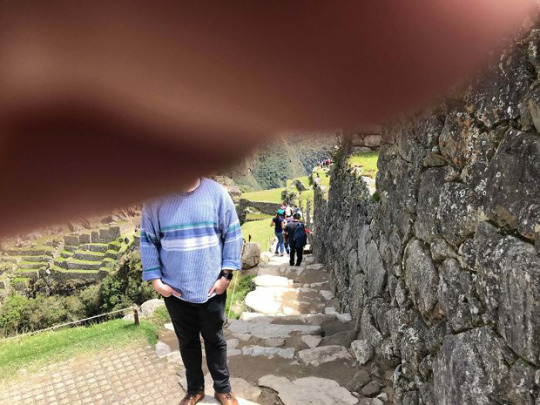
3. A friend of mine traveled to Italy because he wanted to make a difference and made the leaning tower of Pisa “straight” back!
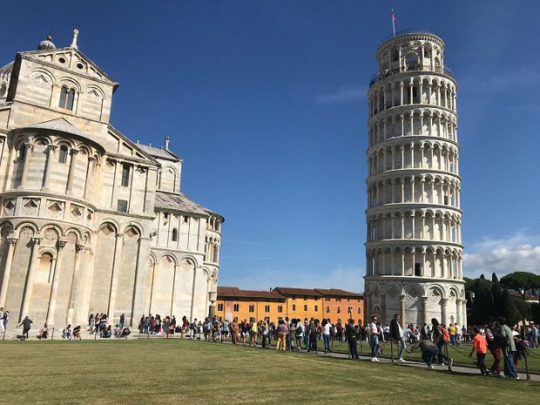
4. Traveling in Paris without seeing the days, the couple pity drinking and looking at each other instead of watching the famous Eiffel Tower from the hotel. Room prices are also quite “acrid”!

5. A tourist also spent his whole sleep to go to Taj Mahal temple (India) at 5am and took this picture.
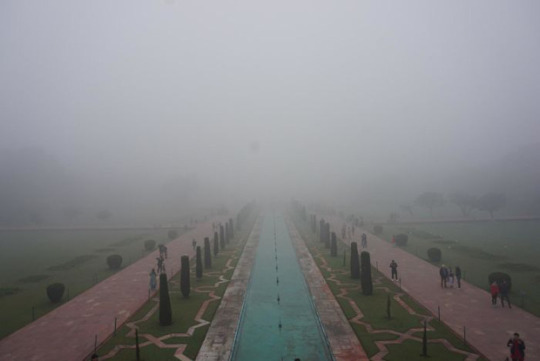
6. If you want to see Havasu Falls in the US but forget to see the date, this is the end!
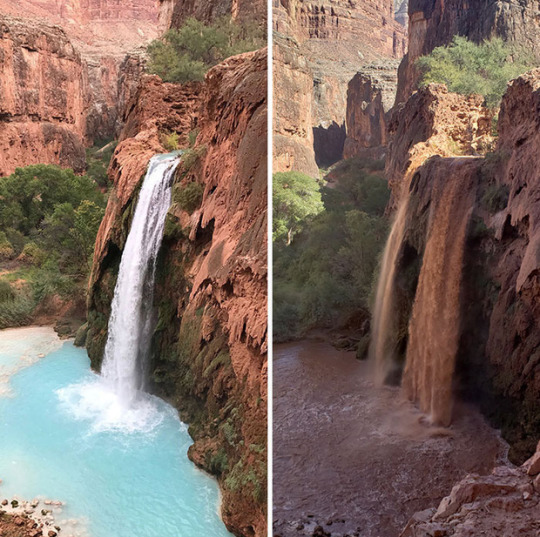
7. The day I visited the Great Wall, it was also cloudy like this …

8. Heard that standing from this angle is a good shot for the Golden Gate Bridge?

9. And here are photos of two “ill-fated” tourists with Mount Fuji in Japan during the last trip.


10. Traveling to Hawaii alone, the girl asked a certain tourist to take a picture for herself and the ending couldn’t be more “bitter”!
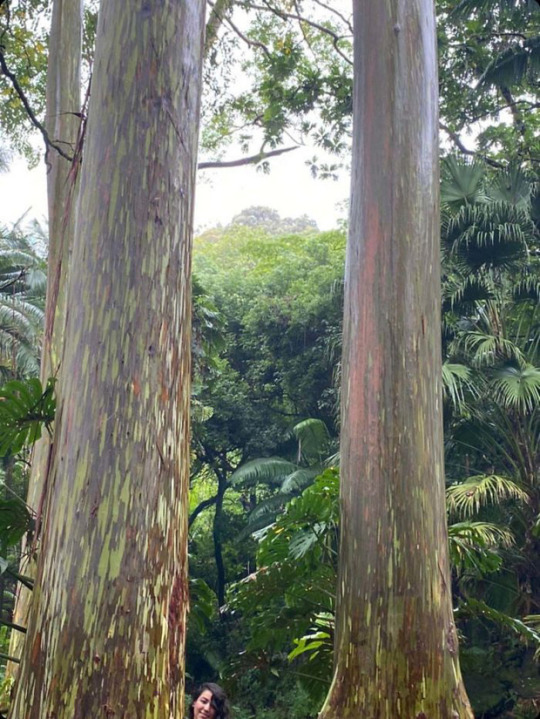
11. It is said that standing from this observatory will be able to capture the eyes of New York City from above. Are you going to cheat?
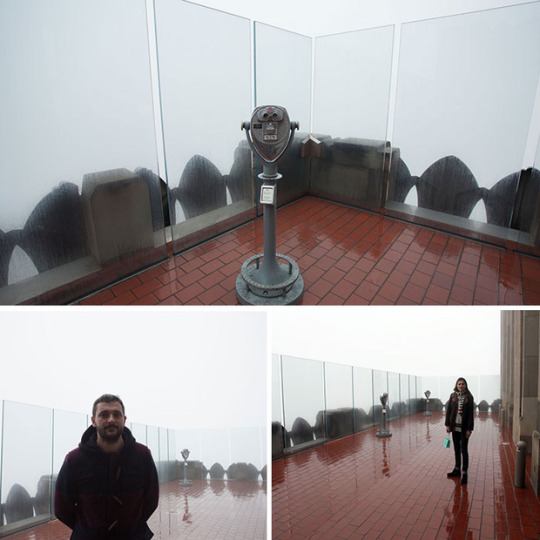
12. Take the long distance dive to the Azalea & Rhododendron Kromlau park on the outskirts of Germany to see the “magic” gate like a web. But life is not a dream!
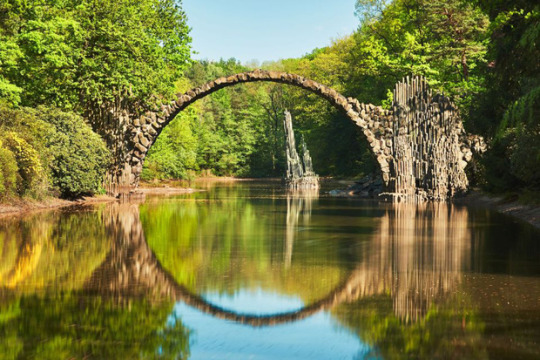
Network photo.
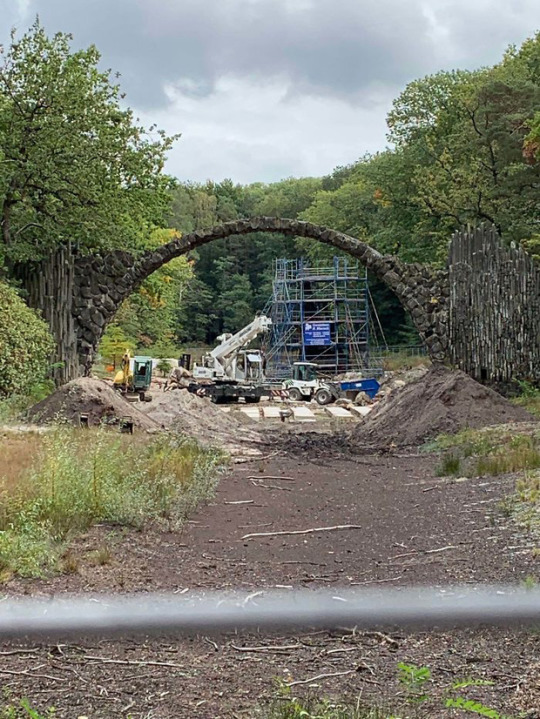
And the harsh reality …
13. Also a case similar to the above, this tourist finally saw the Big Ben clock tower “in flesh” in real life.

14. It costs twice as much to book a room with a 360-degree view of the valley. Never regret that money!
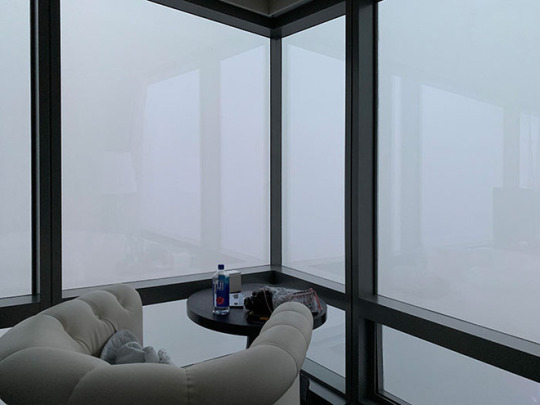

15. Heard of Trolltunga “devil’s” cliffs in Norway is very beautiful, climb up to see where your number “smeared”!
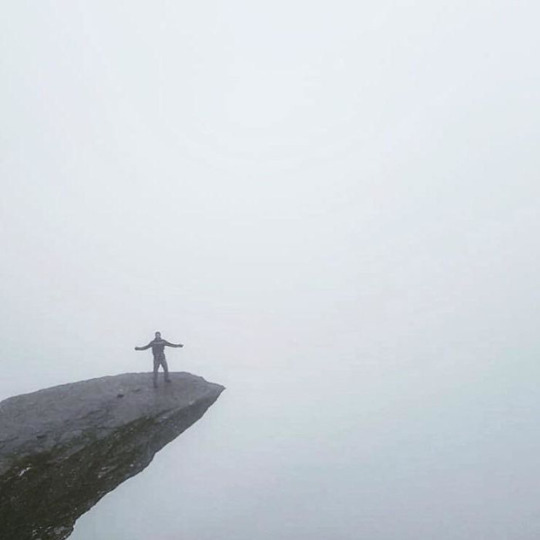
16. City of St. Louis in the US has a gate that is “magic”, but you should also choose the right time when coming here!
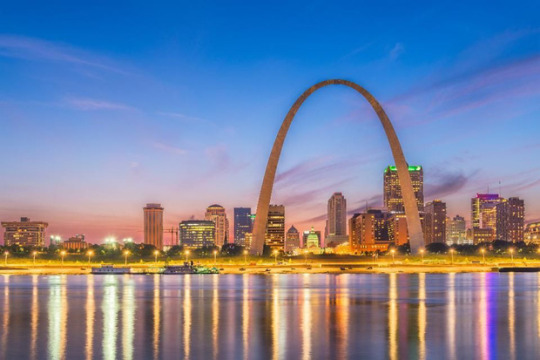
Network photo …
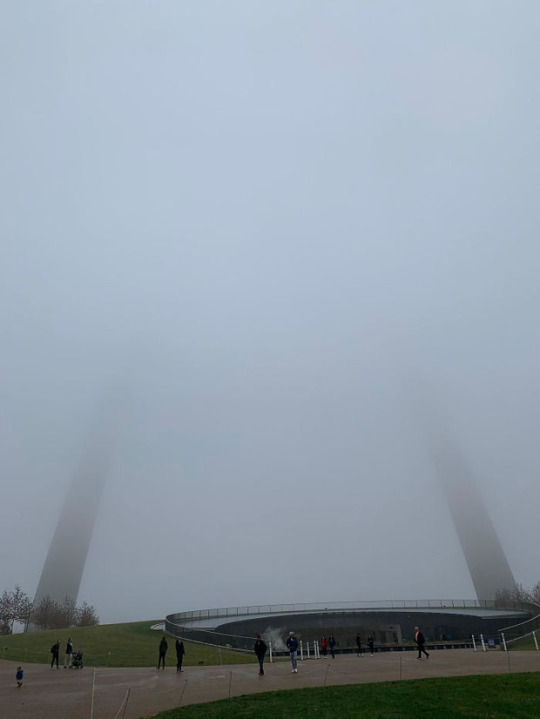
And what sees in real life!
17. The Agung Volcano in Bali (Indonesia) not only has towering columns of smoke. There is also a thick fog!
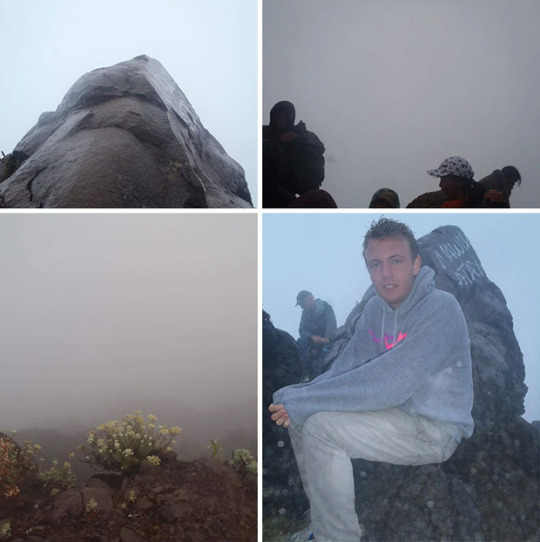
18. The famous Grand Canyon in the US is a very “picky” place for tourists, because going at the wrong time, do not dream about beautiful scenery!
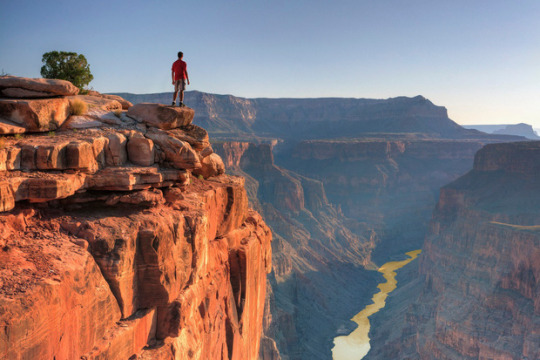
What I wish for …
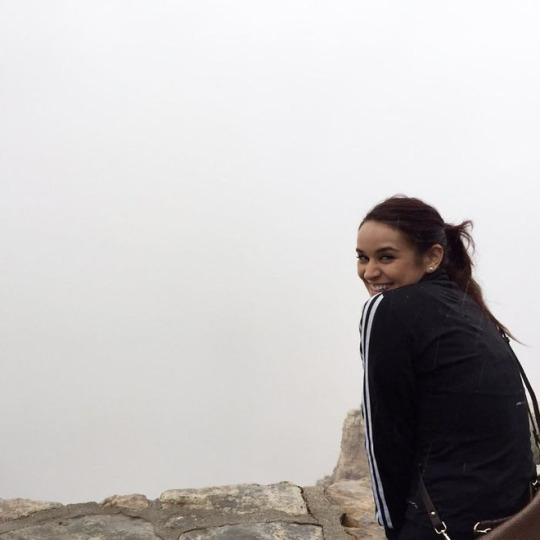
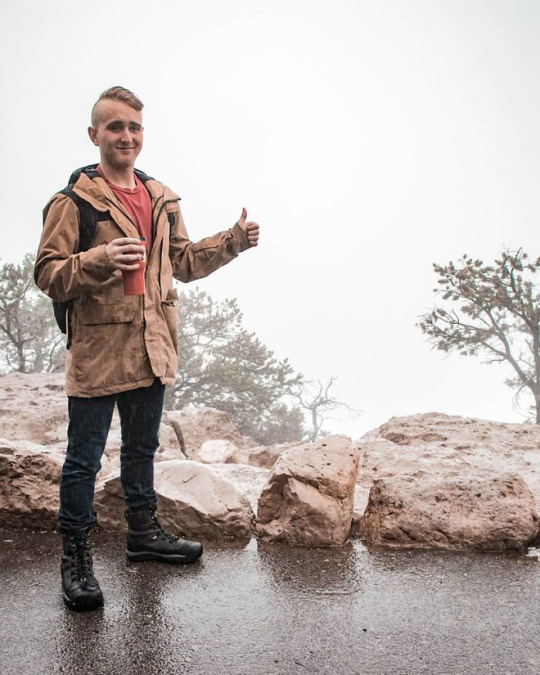
And what receives …
The post Not being able to travel is better than taking the time to go and meet these scenes: It is true that the most unlucky travelers on the planet! appeared first on The Travel Blog Site - Tip Travel Free In The World.
from WordPress https://nhavn.com/not-being-able-to-travel-is-better-than-taking-the-time-to-go-and-meet-these-scenes-it-is-true-that-the-most-unlucky-travelers-on-the-planet/
0 notes
Text
Important information of Machu Picchu
The discovery of Machu Picchu
Hiram Bingham ‘rediscovered’ the Lost City of the Incas in 1911. However, Machu Picchu was already known to some local families, long before the arrival of the Yale University professor.
According to the Cusco writer Américo Rivas, 9 years before the arrival of Hiram Bingham at Machu Picchu, the Peruvian farmer Agustín Lizárraga visited the Inca Citadel. In the place he left his name written as proof of his visit.
Hiram Bingham baptized Machu Picchu as the ‘Lost City of the Incas’, because when he arrived there; He believed that it was the city of Vilcabamba, the last refuge of the Incas after the conquest.
Bingham's team extracted a total of 40,000 artifacts from the Inca City of Machu Picchu to be taken to Yale University.
These objects included silver statues, jewelry, bones, ceramics, and even mummies. Most of these objects have been returned to Peru as of 2014.

Chosen Wonder of the World
Machu Picchu was declared in 1983 as a Cultural Heritage of Humanity by Unesco.
Machu Picchu was declared one of the new 7 Wonders of the World in 2007. In addition, the Taj Mahal, the Great Wall of China and four other impressive places were included.
Machu Picchu is the most visited tourist attraction in Peru, South America and one of the main destinations in the world.
Machu Picchu was chosen in 2016 as the best destination in the world in a vote by the users of the travel website ‘TripAdvisor’.
The construction of Machu Picchu
The ‘Lost City of the Incas’ is located in the middle of two mountains, 2,430 meters high. These two mountains seen from the ‘Casa del Guardián’ form the classic postcard of Machu Picchu.
Machu Picchu is a Quechua word (the language of the Incas) that means ‘Old Mountain’.
The City of Machu Picchu was built as a royal residence for the Inca and his family in the mid 1400 AD, by the Inca Pachacútec.
Since its re-discovery, more than 30% of Machu Picchu has been rebuilt to give a clearer idea of what the structures originally looked like. The restoration continues today.
Machu Picchu was built around 1450 during the height of the Inca Empire. In 1572, a little over a century later, it was abandoned after the arrival of the Spanish.
The Inca Inca Citadel of Machu Picchu ’
Machu Picchu buildings are made of stones that fit perfectly and have remained that way for more than 500 years without the use of any type of forge, mortar or glue. More Unformation Of Machu Picchu Tour
More than 50% of Machu Picchu is underground as a base for some buildings or as water channels and drains for rainwater, irrigation and consumption.
Machu Picchu is divided into 2 zones: agricultural and urban. It is estimated that just over 1,000 people lived in this city hidden in the mountains.
Machu Picchu was never finished, it was only abandoned. Thanks to this, the Spanish could not destroy or modify it as they did with other Inca cities.
Machu Picchu had enough water sources and enough terraces to comfortably support more than 4,000 people. This is four times the population that once inhabited the city.

The Inca Trail to Machu Picchu is considered one of the best walks in the world. Without a doubt, it is one of the most spectacular way to enter Machu Picchu.
The incredible Huayna Picchu mountain
The Machu Picchu National Park houses the Huayna Picchu mountain. This mountain is so popular that if you want to come in the high season, tickets must be reserved 6 months in advance.
To get to the top of the Huayna Picchu mountain you will go through trails and stairs. In some cases, the stairs are built on the side of cliffs several hundred meters away.
Just seeing the images of the Huayna Picchu road discourages many people. However, there have never been any accidents to regret.
In the middle of the Huayna Picchu mountain is the Great Cavern or Temple of the Moon. The function is this mysterious construction in the middle of the cave is still a mystery.
Huayna Picchu is considered one of the most incredible short walks in the world. The entrance ticket is the most desired in Machu Picchu. Machu Picchu Tour Information
Machu Picchu in danger
There is a restriction to enter the airspace of the Machu Picchu National Park. Despite this, the Inca City was flown over by helicopter for Peruvian President Ollanta Humala in 2016.
There was a monolith in the Main Plaza of Machu Picchu. This was removed on two occasions for the plaza to act as a heliport. The first time for the kings of Spain and the second for a group of leaders of the Andean Community of Nations.
The second time this monolith was removed, it was destroyed and buried in the vicinity of the Main Plaza.
Machu Picchu is on the watchlist of the 100 most endangered historical monuments in the world.
Machu Picchu is the most important tourist attraction in Peru. This causes it to be continuously threatened by commercial forces that promote the construction of luxury hotels and tourist restaurants near the wonder.
The mysteries at Machu Picchu
Machu Picchu can surprise anyone who visits it for the first time. Especially when you consider that the construction of the city was carried out without using draft animals, iron tools or the wheel.
It is still a mystery how the huge rocks moved from the quarries (30 km), to the location of the Inca City on the mountain.
Many of these rocks weigh more than 150 tons. It is believed that they were pulled by hundreds of men, but this is unlikely, especially due to the rugged terrain and inaccessible city.
More and more people are coming to Machu Picchu in search of their energy.
The Intihuatana (Solar Clock) is an Inca structure located near the Main Plaza of Machu Picchu. It is believed to emit energy. Many tourists put their hand out to feel it.

5 things few know about Machu Picchu
Currently, there is a family that claims Machu Picchu as their property by inheritance. The dispute with the Peruvian state is in the courts of Cusco.
Machu Picchu was built with a stone assembling technique called ‘Sillar’. The perfect fit of its walls and its slight inclination is still maintained despite its location between two geological faults.
Unesco has set a limit of visitors per day. The objective is to preserve the Inca Citadel of Machu Picchu in the face of excessive tourism traffic.
Machu Picchu is still a mystery. A secret door was recently discovered where the tomb of Pachacutec, the Inca who ordered the construction of the Inca City, would be found.
From the top of Machu Picchu you can see a human face in profile in the conformation of the mountain. The face of an Inca!
Machu Picchu Tours
#Machu Picchu#MachuPicchu#Machu Picchu tours#Machu Picchu tour#machupichuperu#travel#Travel Peru#travel to peru#travel to machu picchu#Travel to Cusco#cusco andean tour#cusco andean tours
0 notes
Text
Guides & Tips to visit Lima in 24 Hours

Perú is one of the Latin American destinations that arouses most interest in travelers, not only for its exuberant nature but also for the mixture of cultures in recent years, which has made it a country with a rich historical and gastronomic heritage of the world.
Lima, the capital of Peru, is usually the entrance and exit of the country since there is the Jorge Chavez International Airport. Of the ten days that foreign tourists generally spend in Peru, according to official data, at least 24 hours of their trip are dedicated to getting to know the city of Lima. And it is not for less: this large city of almost 10 million inhabitants hides many secrets. If you only have one day to enjoy Lima, this guide becomes essential to discover and savor it.
Historic walk in the morning

The historic center of Lima is considered a UNESCO World Heritage Site and, for that reason alone, deserves to be visited. The City of Kings, as it was known, houses perfectly preserved Baroque and Renaissance colonial-style buildings. The nerve center has numerous churches and convents, such as the Monumental Complex of San Francisco de Lima, a 17th-century church and convent whose interior hides the catacombs that served as a cemetery during the colonial era, and the Basilica Cathedral of Lima, 1535 and in which several architectural styles are mixed. Also worth visiting is the Church Museum of the Convent of Santo Domingo and the Recoleta Church, with a surprisingly blue color.
The historic center is full of squares. In addition to the Plaza de Armas, where the official buildings are located, the Plaza Mayor, the center of the old colonial city, and that of San Martín stand out, where two important arteries converge: Avenida Nicolás de Piérola and Calle Jirón de la Unión. Around it is other historic buildings such as the Hotel Bolívar and the Teatro Colón.
Walking through its streets, it is not difficult to run into any of its parks - University, Exhibition or the Magic Water Circuit - and numerous houses with elegant balconies, both colonial and Republican, very representative of this part of the city.
Enjoy the Costa Verde in the afternoon
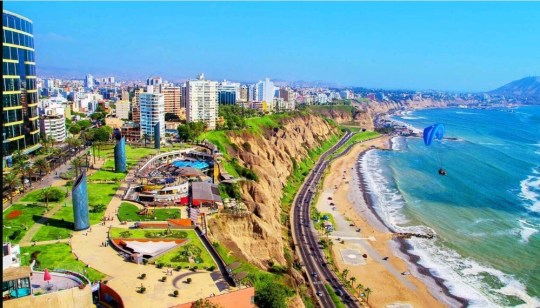
The neighborhood of Miraflores and the Barranco are the most representative of the city. The first is one of the most cosmopolitan areas of Lima, in addition to the financial center. It is worth taking a walk along its extensive Malecon, which borders the cliff and has one of the best views of the bay. One of the most frequent routes is the one that begins in the Lighthouse, continues through the Raimondi Park (track of the paragliding flights) and the Love Park, which receives its name from the statue known as 'The Kiss'. Later, the modern Villena Rey bridge is crossed to reach the Larcomar Shopping Center, an open space overlooking the sea and housing a contemporary art room. This walk ends at the Bajada de Armendáriz, a large slope that reaches the Pacific.
Two essential steps in Miraflores: the archaeological site of Huaca Pucllana, a citadel of the Lima Culture aborigines that inhabited the area between 200 and 700 AD, consisting of a 25-meter pyramid, and the Amano Museum, pre-Columbian textile and other instruments from cultures like Chancay, Nasca or Wari.
And from the most cosmopolitan side of Lima to the most bohemian. Barranco is the neighborhood of the sea, color, and art. His nineteenth-century mansions are home to poets, musicians, and writers. There are the museums of the beginning of the century, such as Pedro de Osma, or the house of the renowned Peruvian artist Víctor Delfín. Also the Mario Testino museum, with samples of the work of the Peruvian fashion photographer. The view of the Bridge of Sighs is essential, a symbol of Barranco and a place of inspiration. Legend has it that whoever sees the bridge for the first time and crosses it without breathing, will fulfill any wish he asks.
Sabor Peru at night

Lima is the Gastronomic Capital of Latin America and the Best Culinary Destination of the World for the World Travel Awards 2019. Dishes as diverse as ceviche, chicken chili, sauteed loin, fish tiradito or the Lima cause are a reflection of the history of the country. In Miraflores, you can choose from the finest restaurants, such as the Nikkei cuisine of Maido by chef Mitsuharu Tsumura (a combination of Japanese and Peruvian specialties) or the elegant Central of chef Virgilio Martínez.
For a dinner in front of the Costa Verde, the Nautical Rose and its renowned Peruvian and international food. It is also recommended Astrid and Gastón of chef Gastón Acurio -in the San Isidro neighborhood-, the capital's insignia for two decades.
For more affordable prices, the Barranco neighborhood offers a multitude of options: Isolina, Mi Perú, Chifa Unión, the Bodega Verde, Las Vecinas Eco Bar or Cala. After the evening, the Boulevard de Barranco offers good music in places like La Noche or Ayahuasca.
Peru: land of ancient wealth
Peru is much more than Lima and these four visits are inescapable:
Machu Picchu
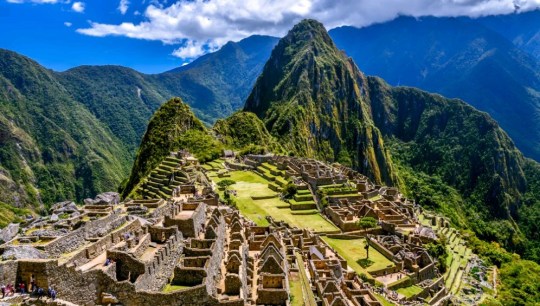
The construction dates back to the 15th century and was declared a Historic Sanctuary - National Archaeological Park of Machu Picchu almost four decades ago. In addition, it is a Unesco natural and cultural mixed heritage, being considered an important political, religious and administrative center of the Inca era.
Cusco (Cuzco)
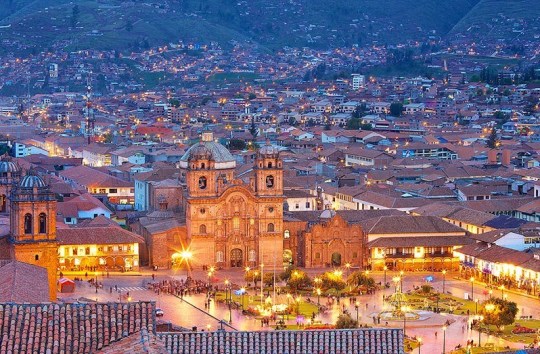
The gateway to Machu Picchu, capital of the Inca Empire that later became a colonial city, and the navel of the world. A peculiar city at 3,400 meters high where you can find the artisan district of San Blas or its imposing streets built of stone.
The Inca Citadel is located in the middle of the rainforest at more than 2,400 meters above sea level, in the Sacred Valley, where the Salineras de Maras or the picturesque town of Paucartambo are also located, characterized by maintaining the ancestral Andean culture.
Nasca's lines

These ancient hieroglyphs extend over an area of 450 square kilometers in the Nazca desert. These stylized figures of 50 to 300 meters, made in a single stroke, are one of the greatest mysteries in the History of Humanity.
Titicaca lake
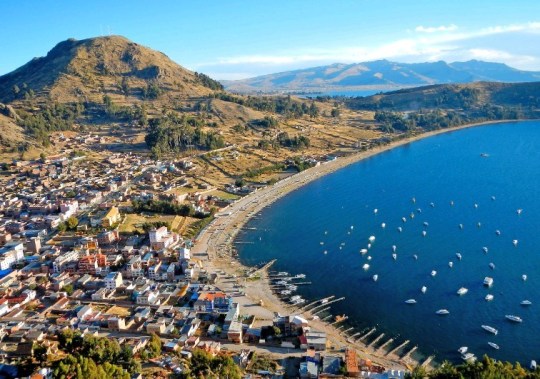
It is the tallest and navigable in the world. Its icy blue mass surrounds the city of Puno and one of its floating islands, Uros, has a total of 40 houses built on totora (a type of reed that grows underwater), they seem magic. Its inhabitants, Aymara, are one of the oldest Andean civilizations, prior to the Incas.
Read the full article
0 notes
Text
Lima, Machu Picchu, Cuzco - Travel Perú
FLIGHT TO LIMA
Private transfer in the bohemian district of Barranco. It will occupy the neo-Tudor house of sculptor Victor Delfin. The garden, viewpoint overlooking the ocean, houses a strong and unleashed animal statuary. In the house, white walls and dark wood contrast; The paintings multiply the colored keys. With excellent bedding, your room overlooks the garden. The breeze ensures a natural and gentle ventilation. The elegant simplicity of places has a stripping effect in the environment. The breakfast too. Guests can use the pool, but Playa Barranco is just below, at the foot of the small cliff.
DAY 2 LIMA
Barranco's reputation is not new. In the 19th century, the Limenian aristocracy frequented the beaches. Today, creative people from all walks of life have invested buildings and casinos. The owners of galleries, restaurateurs, coffee makers followed. The public benefits of the Museum of Contemporary Art, as well as the flower gardens. Listed as a UNESCO World Heritage Site, the Cercado, Old Lima, offers splendid examples of Spanish colonial architecture, such as the Torre-Tagle Palace (18th century) or the San Juan Cathedral (17th century), which houses Tomb by Francisco Pizarro. Maybe we want to visit a museum? The Larco Museum, for example, whose collections cover several millennia of Peruvian history until the colonial period: all ancient cultures were reviewed.
Optional - Barranco in private.
Information that may interest you:
how many days in machu picchu
salkantay trek distance
3 day inca trail hike
maras salt mines tour
train to machu picchu
peru activities
inca trail opening dates 2020
DAY 3 LIMA - CUZCO - URUBAMBA
Private transfer to the airport and flight to Cuzco. New transfer to Urubamba, in the sacred valley. Installation for three nights in the northwest part of town. The contemporary Andean architecture of the hotel generously houses the light. Interior, white wood furniture, light, nice. The rooms, clear and crisp, make life easier. In his window, we get carried away by the landscape. Around the buildings, a garden, where it is good to meet at night near the fire. Andean-style breakfast is also served after five o'clock. The early risers will not waste a minute! The small spa (massages, sauna, jacuzzi) also offers excellent services to organizations requested for long days of visit.
DAY 4 URUBAMBA
Already planned for the program: local markets bring everyone together in a riot of bright colors; the highland Indians recognize themselves as their red poncho. By car, with driver, we go to visit. Starting with Pisaq: market (fresh cheese, chicken, herbs, bread, cabbage, guinea pigs, corn and potatoes of all kinds), centennial agricultural terraces and Inca citadel. At the other end of the valley, the fortified site of Ollantaytambo is a very well preserved example of Inca urban planning.
DAY 5 URUBAMBA
Already planned for the program: they bring us to the area by car and, in the company of a private French-speaking guide, we begin our explorations on the concentric terraces of the Inca Moray Agricultural Research Center. The device allowed to reproduce artificially different climatic conditions and, therefore, to develop protocols to acclimatize exotic plants. Then we will descend gently through a beautiful country that dominates the Vilcabamba mountain range, to the Maras salt flats, whose thousands of ponds make up a strange white and alveolar landscape. This day in the countryside, has about three hours of walking.
DAY 6 URUBAMBA - OLLANTAYTAMBO - AGUAS CALIENTES
Transfer to Ollantaytambo train station and panoramic train to Aguas Calientes / Machu Picchu Pueblo.
Already planned for the program: on the ferry that follows the winding road, we prepare for the crash. Because Machu Picchu, the citadel of Pachacutec, is a feat of such a level that one is speechless. The beauty of the mountains, the scale of design, logistics and engineering needed to build, the vigor, the genius that the Incas have shown here, are beyond doubt. Astonishment, in the strong sense of the word! To go beyond the simple feeling of wonder and give yourself the means to understand majesty, a private French-speaking guide is an excellent interpreter.
Night at the north end of town. Contemporary buildings along which dried eucalyptus branches make a recurring pattern and as a signature. Interior, general black and white. In the living room, fresh sheets of Peruvian cotton. The restaurant offers national and international cuisine whose ingredients are mainly organic. This last requirement also applies to spa care products. Which, installed on the upper floor, opens with large bays in the rainforest.
Information that may interest you:
machu picchu tours
rainbow mountain peru
palcoyo mountain
inca trail 2 day vs 4 day
inca sun god
sacred valley itinerary
peru monuments
Machu picchu honeymoon
jungle trek to machu picchu
choquequirao trek 4 days
inti raymi machu picchu
DAY 7 AGUAS CALIENTES - OLLANTAYTAMBO - CUZCO
Transfer to the train station and panoramic train to Ollantaytambo. Private transfer to Cuzco. The installation for three nights three blocks from the Plaza de Armas, in the old city, Peruvian folk art has given the hotel a cheerful and cheerful air, charming colors. Each piece looks like an Andean pop bouquet. However, the facilities are very well designed and comfortable. Breakfast allows you to attack the day in good condition: the spirit animated by the decoration and the body full of energy.
In the program - A pisco tasting. The national drink is a good wine brandy. We go to one of the best addresses in pisco Cuzco, to try it in its classic form of pisco sour.
DAYS 8 AND 9 CUSCO
The navel of the world, the city was probably founded by the Killke a century before the arrival of the Incas. Which had to be enlarged and converted into the capital of his empire. The Spaniards partially destroy it, but melt its Cuzco, Noble and Great City. The meeting of the Andean culture and the baroque effervescence has given surprising results, which seem to define the codes of a unique art of living. The capital of the Incas remains, literally, the base of the city: the walls and foundations often date from the pre-Hispanic period and are found in many places (especially in the old colonial neighborhood of San Blas, where your hotel is located) . In the place of the arms the Cathedral of the Assumption of the Blessed Virgin and the Church of the Company of Jesus are raised, both triumphs: golds and paintings of the school of Cuzco (XVI-XVII centuries). Sacsayhuaman, two kilometers north of Qusqu, is one of the most impressive Inca remains. This triple zigzag wall shaped like a puma head is a tour de force. The cyclopean precision of the monolith assembly leaves one speechless.
Optional: a cooking workshop; archeology and mountain biking.
DAYS 10 AND 11 CUZCO - RETURN FLIGHT
Private transfer to the airport and return flight, via Lima.
0 notes
Text
Paracas: Peru’s perfect escape for a beach getaway
Paracas, Peru (CNN) — While tens of thousands of travelers descend on Peru annually to visit well-known attractions such as Machu Picchu, the Sacred Valley and Lima, one of the country’s most beautiful and interesting spots is virtually ignored by tourists. Paracas, a small coastal town of less than 5,000 residents, lies 150 miles from Lima and is known regionally as the “Hamptons of Peru.” Every weekend, hundreds of Limeños, lured by the promise of sun, sea and surf, travel to the town to indulge in a beachside getaway.

The Paracas National Reserve spans 335,000 hectares. A third of the protected area is desert with the remaining two-thirds allocated to preserving the surrounding ocean.
Favio Ovalle/PROMPERÚ
The town, which is a curious mix of high-end hotels, backpacker hostels, luxury homes and ramshackle storefronts, is one of the county’s most beguiling and untapped destinations.
Brimming with wildlife, stark desert landscapes, gorgeous beaches and captivating history, Paracas is a worthy addition to anyone’s Peru itinerary.
Options for all
It’s no exaggeration to say that there’s something for everyone in Paracas. A picturesque, sun-drenched coastal town with access to some of the world’s most fascinating geoglyphs, it’s a goldmine for outdoor adventurers, history hounds and beach lovers.
Paracas National Reserve
Paracas’ under-the-radar cachet, endless sunshine and beaches and alluring laid-back vibe make it an extraordinary destination. Its geographic setting — a seemingly impossible mix of endless desert and wildlife-rich ocean waters — help it steal the show.
There’s no better place to experience this dazzling landscape than at Paracas National Reserve. Spanning 335,000 hectares, a third of the protected area is desert while the remaining two-thirds is surrounding ocean.
The reserve features stunning rock formations, the most famous being the Cathedral (sadly, it was mostly destroyed in a 2007 earthquake), dramatic cliff faces, gorgeous sandy beaches and tiny fishing villages, like lovely Lagunillas. There are also plenty of wildlife watching opportunities.

Brimming with wildlife, stark desert landscapes, gorgeous beaches and captivating history, Paracas is a worthy addition to anyone’s Peru itinerary.
Sandra MacGregor
Depending on what time of year you visit, expect to see condors, flamingos, rare Humboldt penguins, pelicans, desert foxes, humpback whales, dolphins, sea lions (go to Mirador de los Lobos for the best views) and more. Playa Roja, with its unusual red sand, is the most striking beach on the reserve; Playa de la Mina’s sedate waters are ideal for swimming.
There’s a vast area to cover and the best way to maximize your time is with a bike, ATV or bus tour — tour operators along Paracas’ boardwalk and main street, El Chaco, have increased in recent years.
Islas Ballestas

Islas Ballestas boat tours are likely to result in sightings of sea lions, whales, penguins, dolphins and hundreds of different species of seabirds.
Shutterstock
Forming part of the Paracas National Reserve, Islas Ballestas, teaming with marine and bird life, is a worthy stop if you find yourself in Paracas proper.
Half- and full-day boat tours (which, incidentally are also the only way to reach the islands) give visitors the opportunity to spot sea lions, whales, penguins, dolphins and hundreds of different species of seabirds.
Even if you’re not a consummate birder, it’s hard not to be enchanted by the antics of playful penguins or be enthralled by unexpectedly graceful pelicans diving for fish just feet from your boat.
All of the tours include a stop to gaze at the beguiling El Candelabro. Nearly 600 feet tall, the candelabra-like geoglyph etched into a cliff face is believed to date back to 200 BC but its origins and purpose remain a mystery.
4×4 desert ride/sandboarding
Seeing the desert is one thing, really experiencing it is another. Paracas means “rainstorm of sand” in Quechua (the language spoken by indigenous Peruvians, especially during the Incan Empire) and navigating the massive waves of sand via 4×4 with a professional driver gives you a new appreciation for the majesty and awesome force of this barren, sometimes hostile, landscape. Plus, it’s just plain fun.
Some tour companies (like Venturia) will even take guests sandboarding and end the excursion with a moonlight picnic under the stars. Aim to take a tour that includes a special sunset stop; the image of the sun slowly melting into the desert sand will take your breath away.
Nazca Lines
While not located in Paracas, seeing these enigmatic land features is most often done as a day trip from Paracas. The Nazca Lines are about 3 and a half hours away by bus or visitors can book quicker aerial tours.
There are over 300 figures (including fascinating images of a hummingbird, a monkey, a giant spider and what appears to be an astronaut) scattered over 175 square miles of arid desert in the Nazca Valley. The Lines, which are a UNESCO World Heritage site, are said to be over 2,000 years old.
What’s for dinner

The priciest option in town, Ballestas Restaurant in Hotel Paracas dishes up innovative gourmet dishes that showcase the region’s culinary possibilities.
Hotel Paracas
As would perhaps be expected in an unassuming, seaside town, the food scene in Paracas tends towards casual meals with an emphasis on fresh seafood. Affordable set menus and animated happy hours are a mainstay in the majority of restaurants.
The lively waterfront area features a range of choices from hole-in-the-wall, raucous, footwear-optional eateries, to comfortable, unpretentious cafes serving tasty Peruvian dishes (like ceviche, causa and lomo saltado) alongside Western classics like hamburgers. The town’s few upscale dining options are found mostly in hotels.
Ballestas Restaurant
If you’re looking for a fine-dining experience that highlights the best of Peruvian-Mediterranean fusion cuisine, head to Hotel Paracas’ chic Ballestas Restaurant.
Certainly the priciest option in town, it’s also where you’ll find incomparable, innovative gourmet dishes that best showcase the region’s range of culinary possibilities, much of it revolving around seafood.
Its impressive list of gluten-free options will delight even gluten-eating individuals, and diners won’t want to overlook the extensive wine and cocktail list. The selection of pisco sours, (a quintessential Peruvian alcoholic drink made with pisco, simple syrup, lime and egg whites), is especially tempting.
Chalana Restaurant

The deceptively casual-looking Chalana Restaurant is hands-down the best place to go for fresh, creative seafood dishes.
Sandra MacGregor
One of the restaurants in the Hotel Paracas, deceptively casual-looking eatery Chalana is set on a private dock. It is hands-down the best place to go for fresh, creative seafood dishes.
One of Peru’s few sustainable “zero kilometer food” concept restaurants (hyper-local food that doesn’t travel), all the meals feature seafood sourced from local farms and fishermen who bring their daily catches directly to the dock.
The causa, layered mashed potatoes essentially, is delectable, but the show-stopper is the daily ceviche — think sea bass, octopus and scallops. When served with a glass of Peruvian white wine, it’s ambrosial.

Paracas offers a curious mix of high-end hotels, backpacker hostels, luxury homes and ramshackle storefronts.
Sandra MacGregor
Inti-Mar
Out of town, all the way across Paracas Bay, Inti-Mar is worth the journey for its fresh scallop dishes. No wonder, given that Inti-Mar is also a working scallop farm.
Guests can tour the farm and then dine on divine seafood dishes in the comfy restaurant overlooking the bay or opt for the always-full terrace just steps from the sea. Inti-Mar also runs a small, cozy B&B with six rooms all facing the ocean.
Pukasoncco Arte y Restaurante
To describe Pukasoncco Arte solely as a restaurant is to do it a disservice. As its name implies, this approachable eatery is as much an ode to art as it is to delicious, no-frills Peruvian fare.
Peppered along the walls, and in a larger gallery/workshop next door, is a whimsical collection of the owner, Sansón’s, own works, as well as pieces he’s collected over the years. Sansón is the restaurant’s only chef and waiter so be prepared to be patient — but the wait is worth it for scrumptious, made-from-scratch food. There’s also a variety of vegetarian options and even a couple of vegan menu items.
Ballestas Restaurant, Av. Paracas 173, Urb. Paracas, Pisco, Ica, Avenida Los Libertadores 173, +5156581333Chalana Restaurant, Av. Paracas 173, Urb. Paracas, Pisco, Ica, Pisco, Avenida Los Libertadores 173, +5156581333Inti-Mar, Km 38 Pisco — Punta Pejerrey, +51981318866
Put your feet up

Hotel Paracas is one of just two five-star luxury properties in Paracas.
Hotel Paracas
Many of the Peruvians who frequent Paracas have small second homes in town (which is why it’s known as the “Hamptons of Peru”), so most accommodations center largely around no-frills hotels or hostels. Luckily, the few elegant hotels in town are fabulous.
Hotel Paracas, a Luxury Collection Resort
One of only two five-star properties in town, this Marriott property claims a coveted beachfront location in sheltered Paracas Bay, just five miles from Paracas National Reserve.
The luxurious hotel features three restaurants, a world-class spa and fitness center, free water sports, a kids’ club and two pools. Polished, cottage-like villas with private terraces (some with plunge pools) add to the seaside escape ambiance.
Despite being less than a five-minute walk from the central area of Paracas, the manicured, verdant gardens, protected beachfront and private pier (from which you can catch a tour to Islas Ballestas), could easily trick you into believing you’re alone on your own private island.

Hotel Paracas’ polished, cottage-like villas with private terraces (some with plunge pools) add to the seaside escape ambiance.
Sandra MacGregor
La Hacienda Bahía Paracas
The elegant four-star La Hacienda Bahia Paracas hotel boasts an oceanside location with incredible views of Paracas Bay.
Understated, contemporary rooms feature free Wi-Fi, flat screen TVs and minibars.
Guests will also enjoy a complimentary breakfast buffet, a selection of dining options and live Peruvian music nightly in the Marineros Bar. The large outdoor pool is a crowd-pleaser, and there’s also a spa and a small fitness room.
Hotel San Augustin Paracas
Casual and welcoming, Hotel San Augustin Paracas is known as a family-friendly hotel in a prime location near the city center and popular El Chaco beach. This three-star pick offers clean, unfussy rooms with private, ocean-facing balconies and free Wi-Fi.
There’s an on-site restaurant, a large outdoor pool that overlooks the ocean, a volleyball court and an indoor playroom designed for kids.
A quick walk along the beach path at the front of the property takes guests to the main Paracas pier (which makes it ideal to catch boat tours) and the main area of town filled with shops and restaurants.
Hotel Paracas, Av. Paracas 173, Urb. Paracas, Pisco, Ica, Avenida Los Libertadores 173, +5156581333
The post Paracas: Peru’s perfect escape for a beach getaway appeared first on Tripstations.
from Tripstations https://ift.tt/2PMkI82
via IFTTT
0 notes
Photo

There is something incredible about perspective. We searched for a different angle on some of the places we explore on our adventures, and were amazed how different they look from the sky. Tea plantations become mazes, a spring festival becomes a riot of color, and rivers become something like a watercolor painting. Take a look at these eight stunning aerial photos.
Hovering over a tea plantation in Sri Lanka. On our journey, Sri Lanka, we walk through tea plantations just like these, and later learn the fine art of “tasting” tea.
Learn more about our Sri Lanka adventure
Catching the soft light over Sossusvlei dunes in Namibia. On our unique Namibia Expedition, we overnight at the only lodge inside Namib-Naukluft National Park, allowing us access at sunrise and after sunset, so you can photograph and climb these imposing dunes while the light is right—no need to line up waiting for the gates to open.
View our Namibia Expedition
Known as the heart of the Coral Triangle, Raja Ampat is the world’s richest area for coral reefs (the triangle includes Northern Australia, Indonesia, the Philippines, and Papua New Guinea). We journey through this wondrous realm aboard a traditional double-masted Indonesian schooner, anchoring in beautiful coves, with lots of time to explore above (and below!) the water’s surface.
View Snorkeling Raja Ampat itinerary
In India, we experience the rich traditions of Rajasthan’s more remote towns, with their legacy of ancient temples, palaces, and imposing fortresses, but our main highlight of the journey is Holi Festival, a wildly exuberant event heralding the approach of spring, complete with singing, dancing, and the enthusiastic flinging of vividly colored powder and water.
Learn more about our Hidden Rajasthan and Holi Festival adventure
Iceland is known as the land of fire and ice, and from this unique angle, you can see the country’s extraordinary contrast of color. This is the result of glacial sediments that flow over the black lava landscapes. On our Iceland adventures, we visit a number of different glaciers, including Vatnajökull Glacier, Europe’s largest glacier, and later soak in the famous Blue Lagoon.
View all Iceland trips
You can bet Hiram Bingham didn’t have a view like this over some of the fantastic Incan ruins in Peru. This particular ruin is Saqsayhuaman (12,142′), overlooking the vibrant city of Cusco. We visit this site on many of our Peru journeys and also make our way to Machu Picchu.
View our Peru Adventures
Whitewashed buildings crowned with blue domed roofs is a specialty of Santorini, Greece. We have a wonderful extension to our Greece journeys that spend time wandering through Santorini’s winding alleys and watching the sunset from a lovely hotel perched right on the cliffs.
Check out our Greece adventures
Dotted across Southern Africa are a network of watering holes that are frequented by all sorts of wildlife. We love this image because it shows the paths elephants take, leaving behind a vast web of watery tracks.
See all our trips in Southern Africa
1 note
·
View note